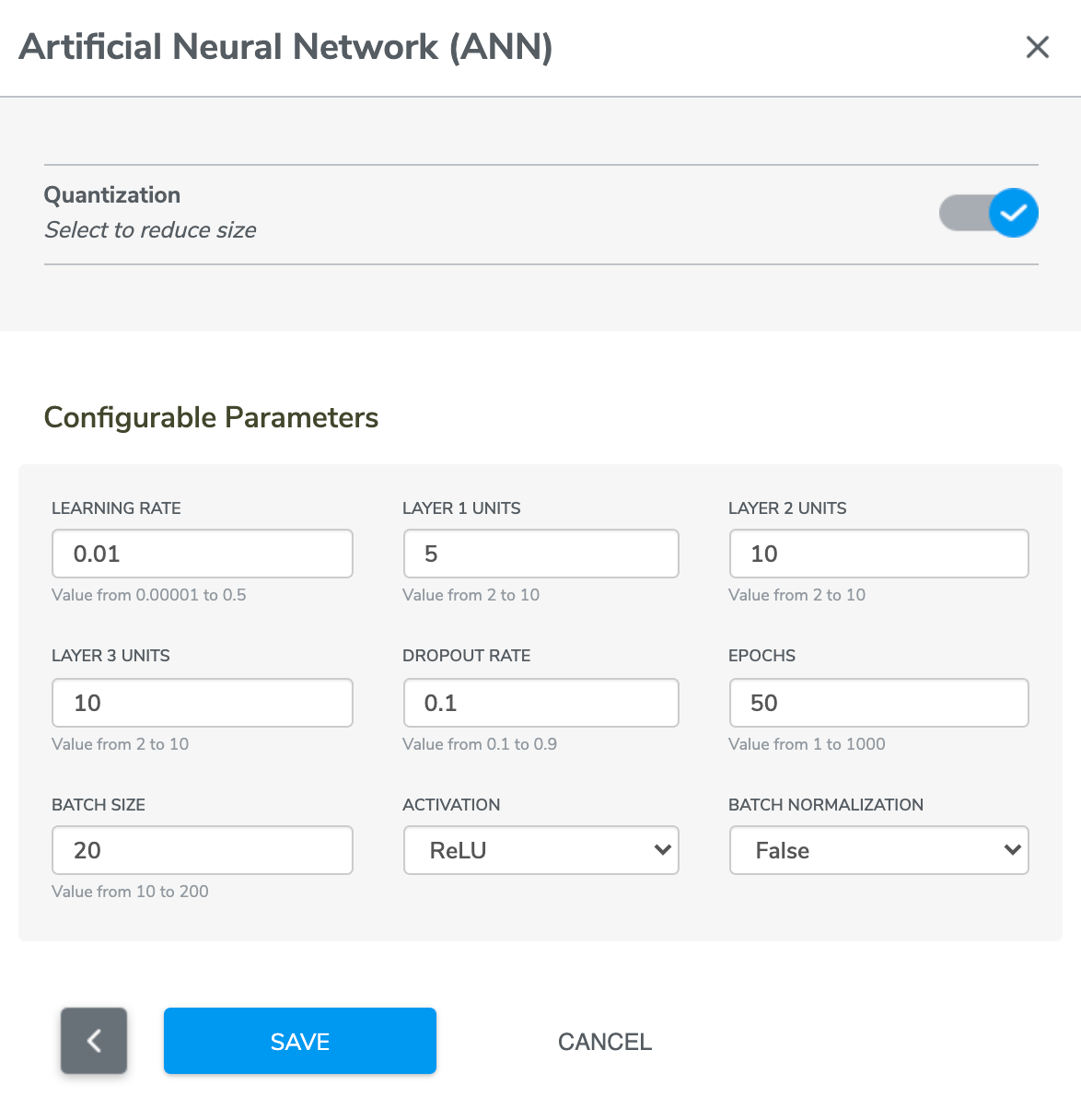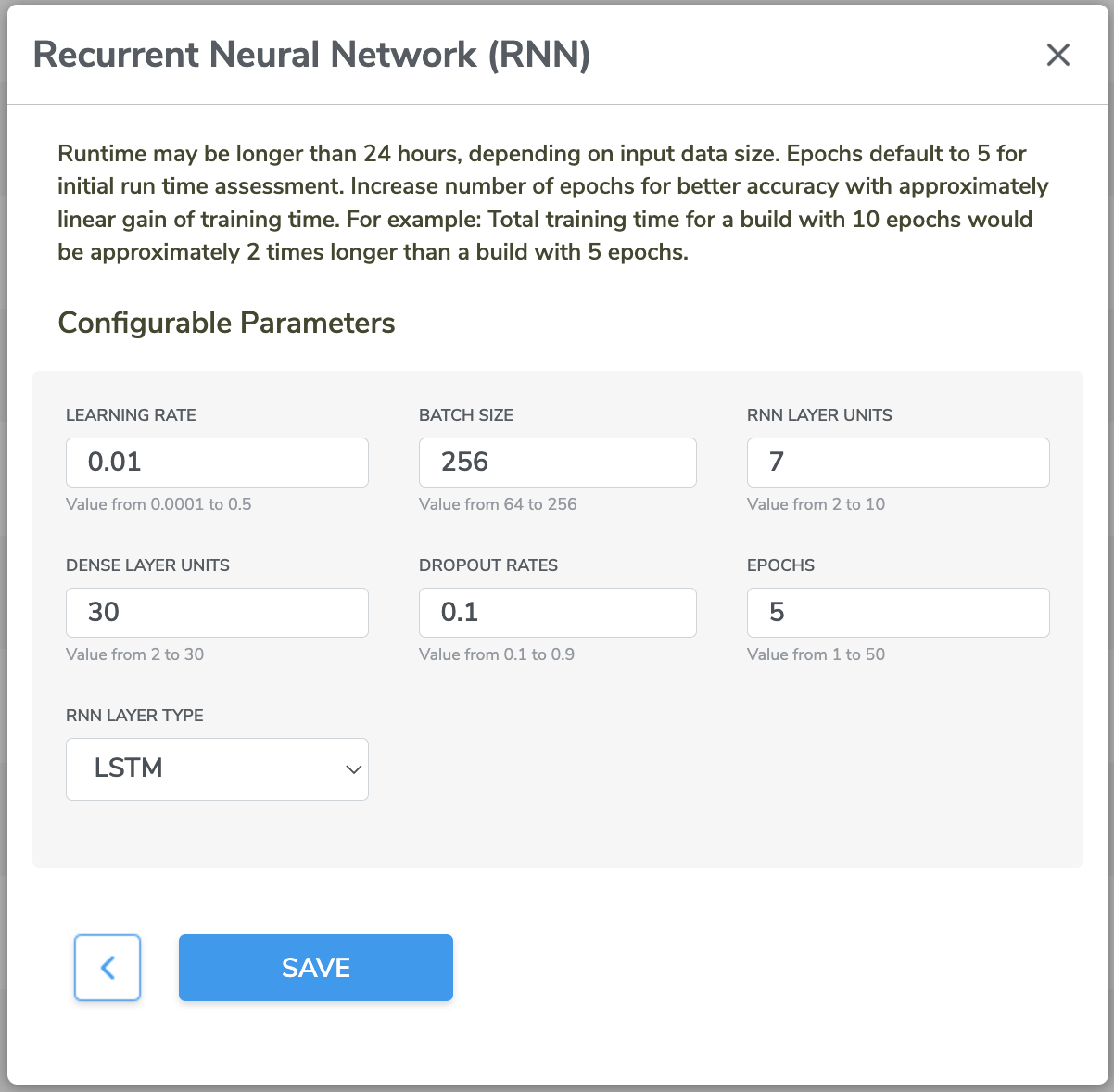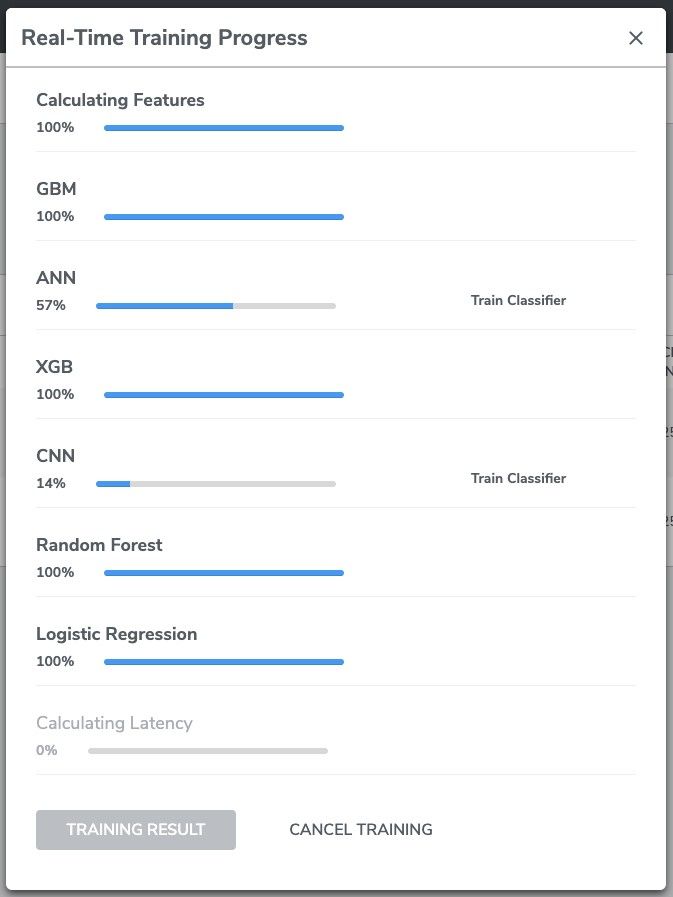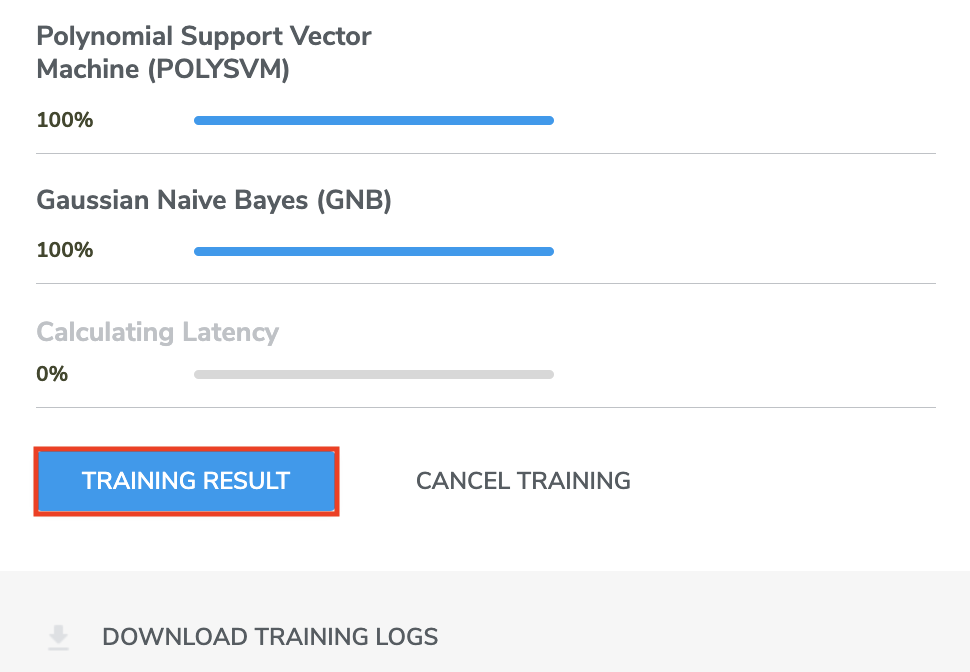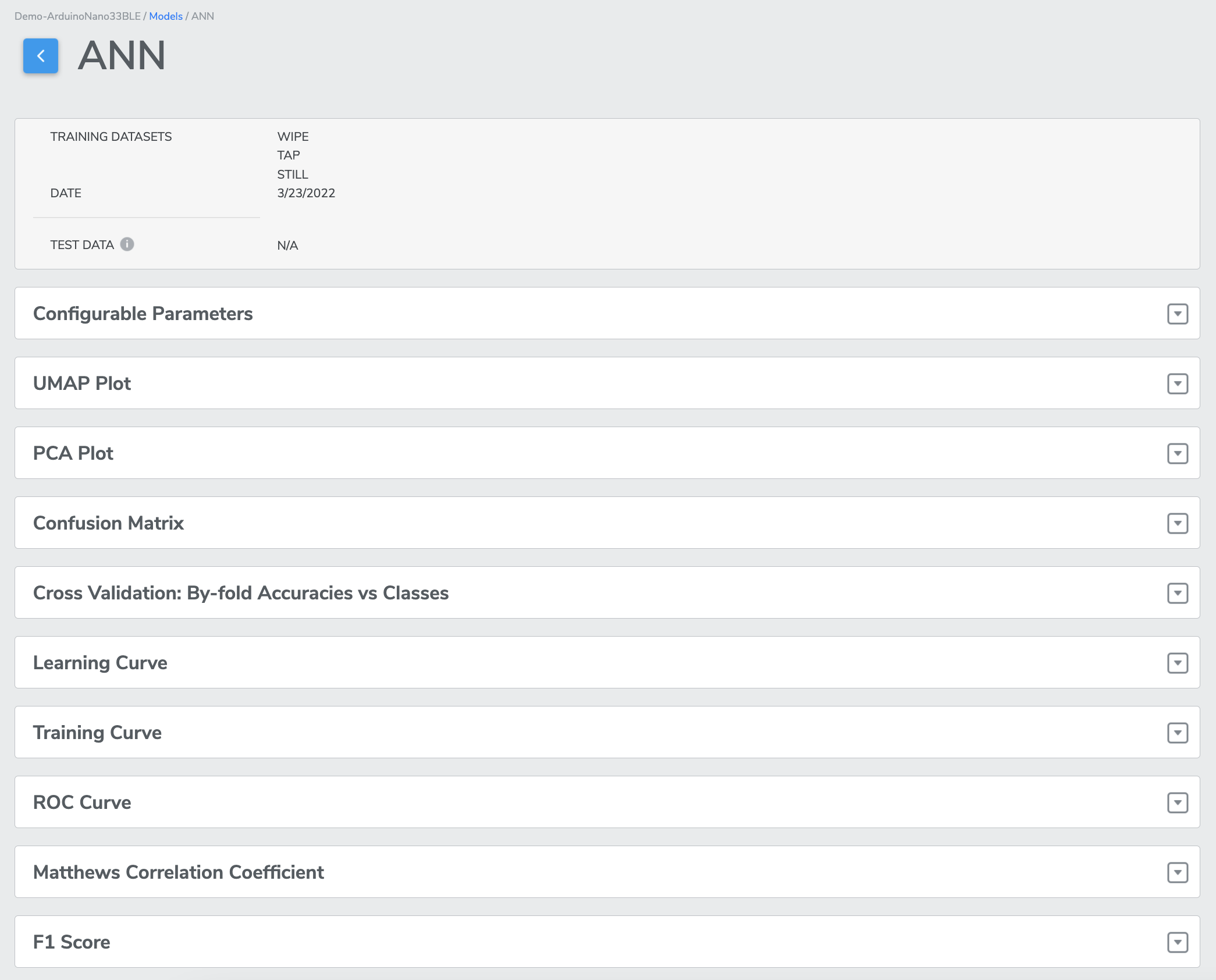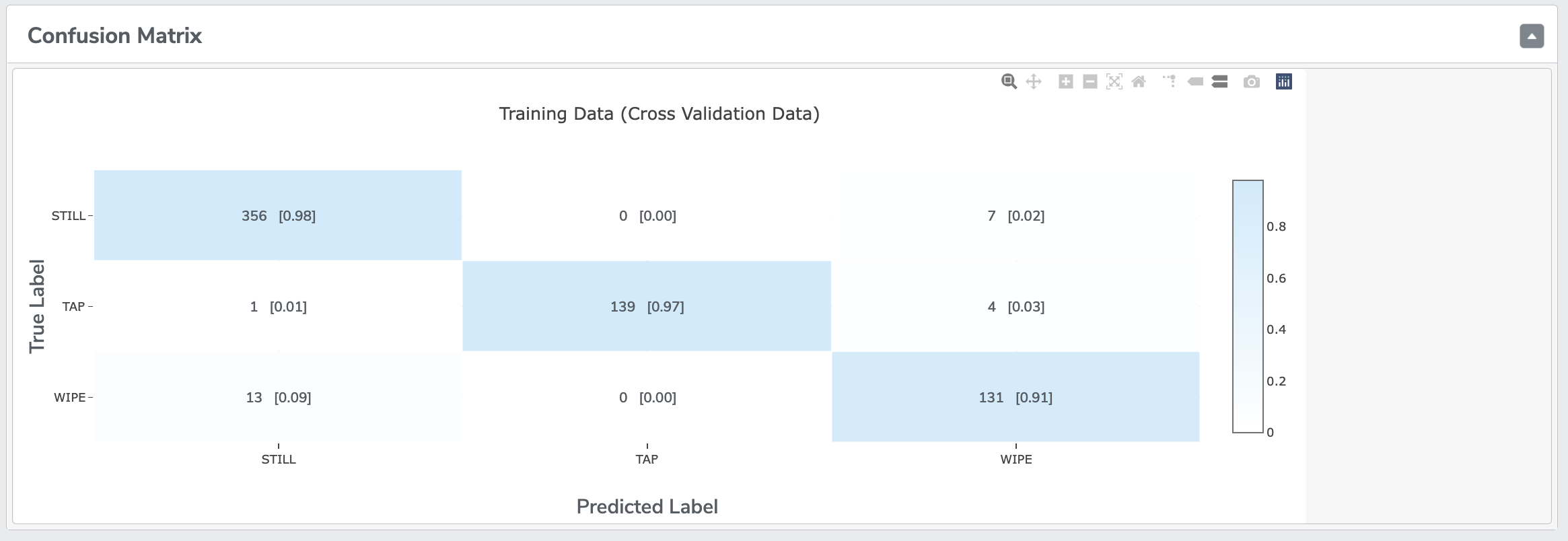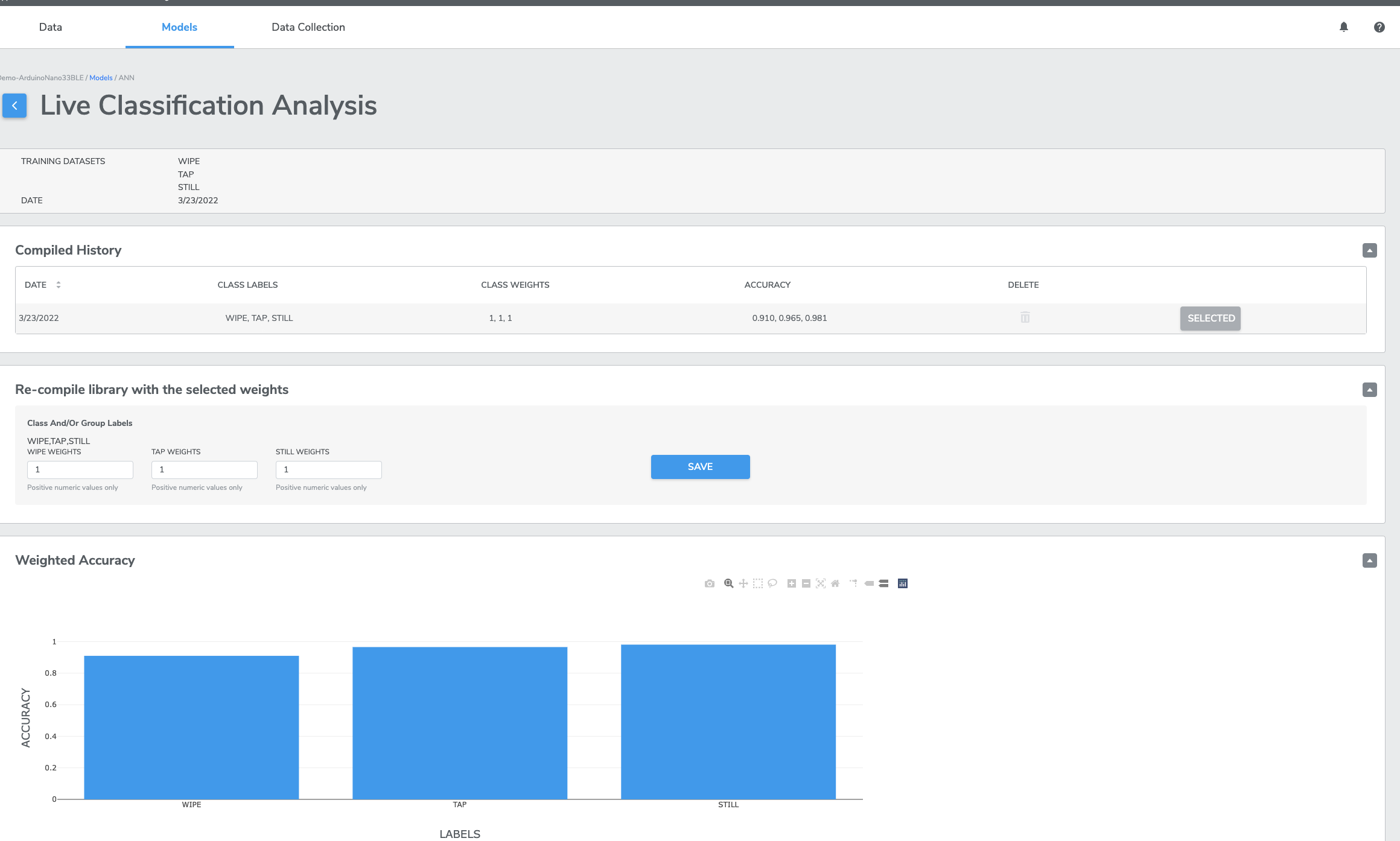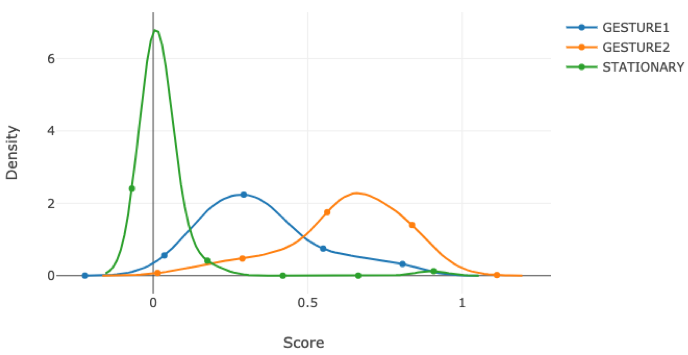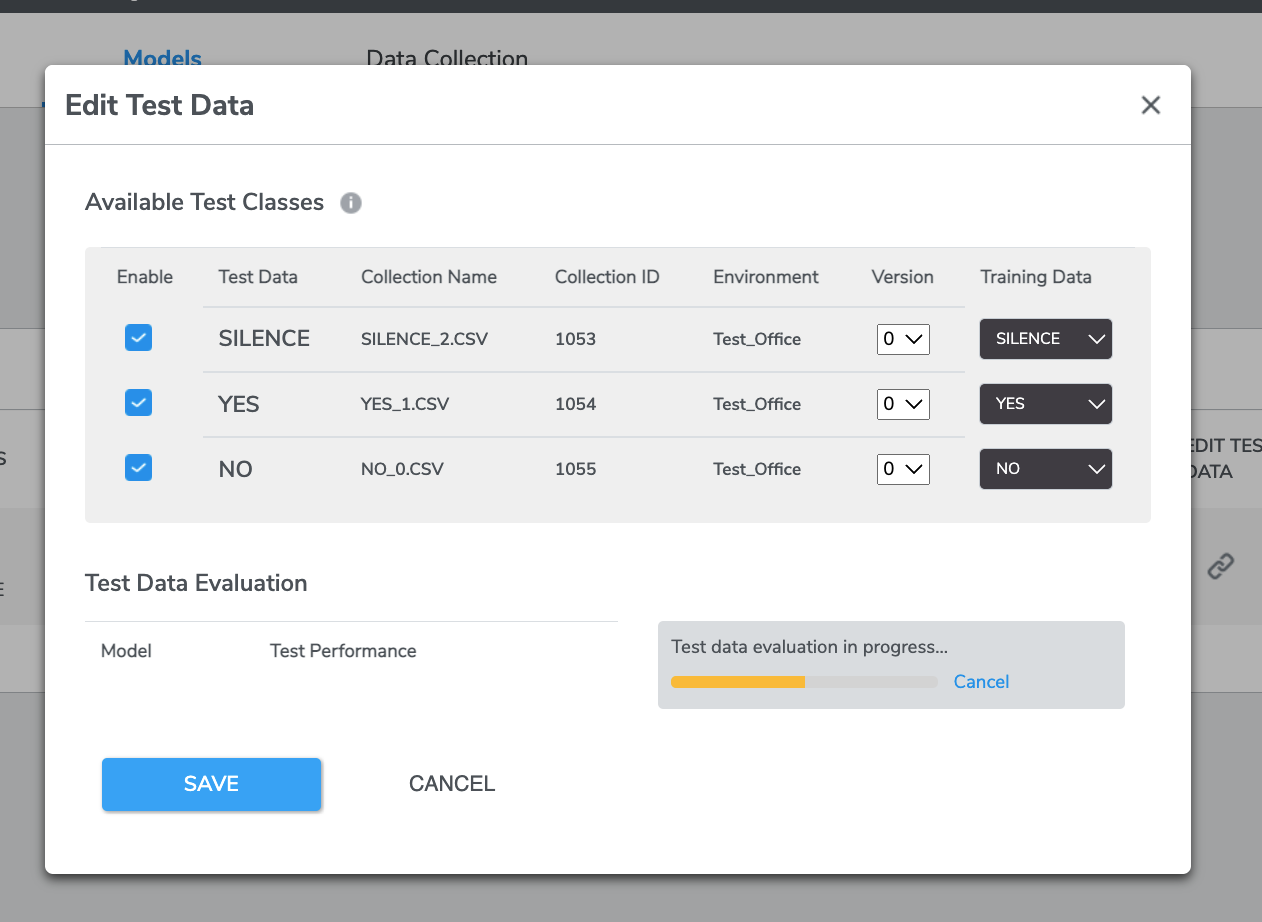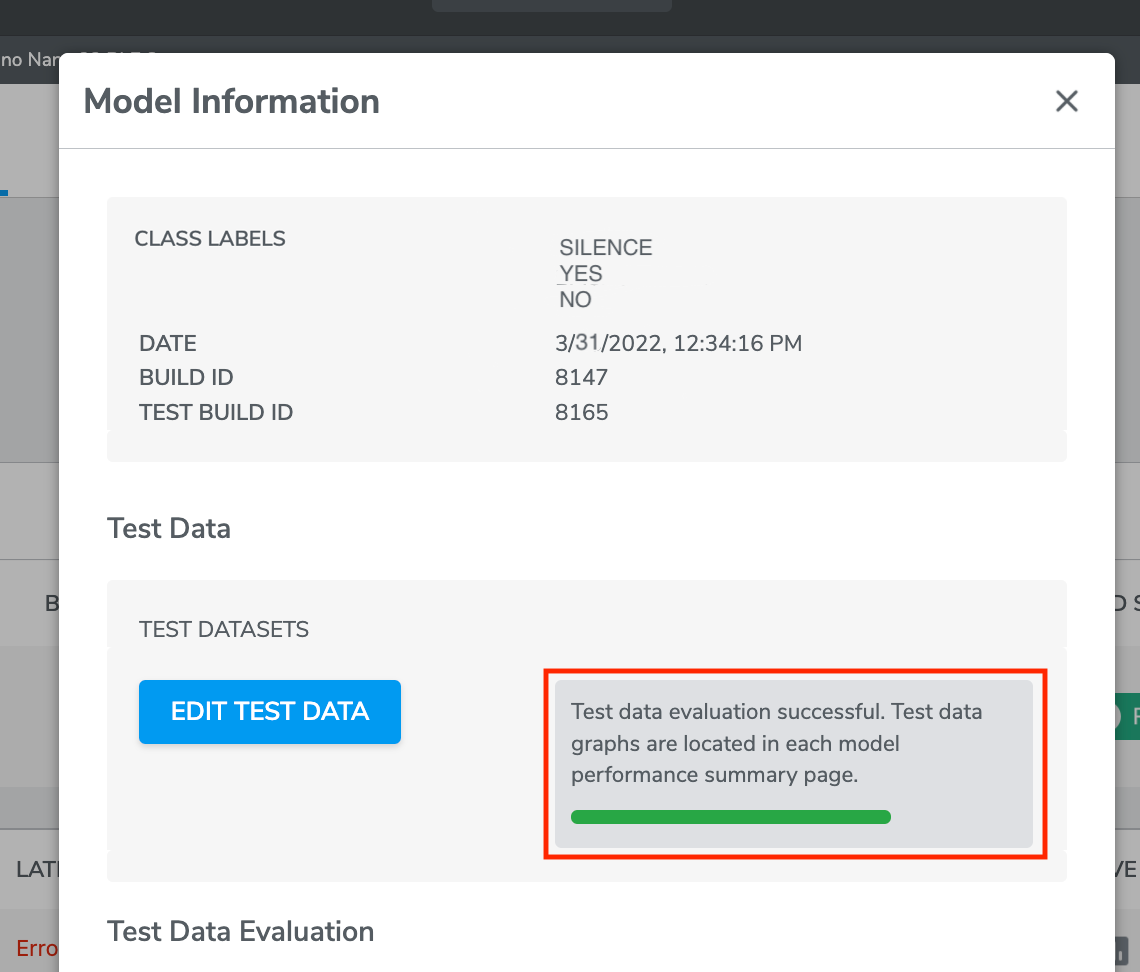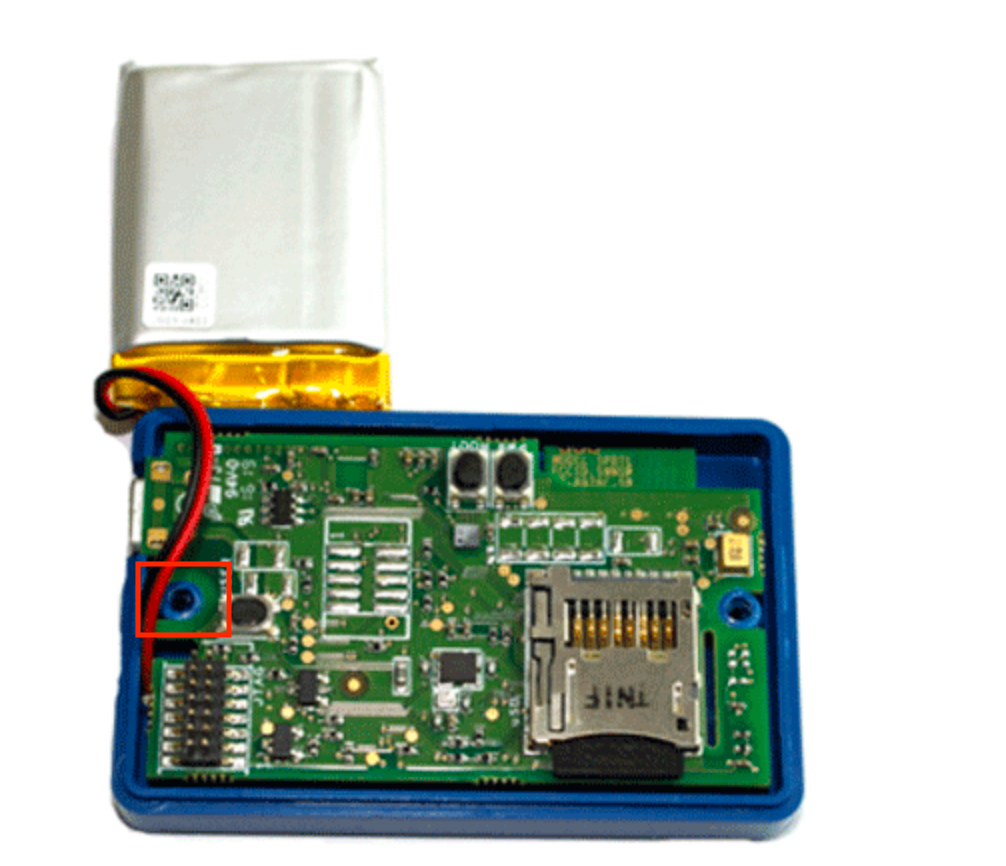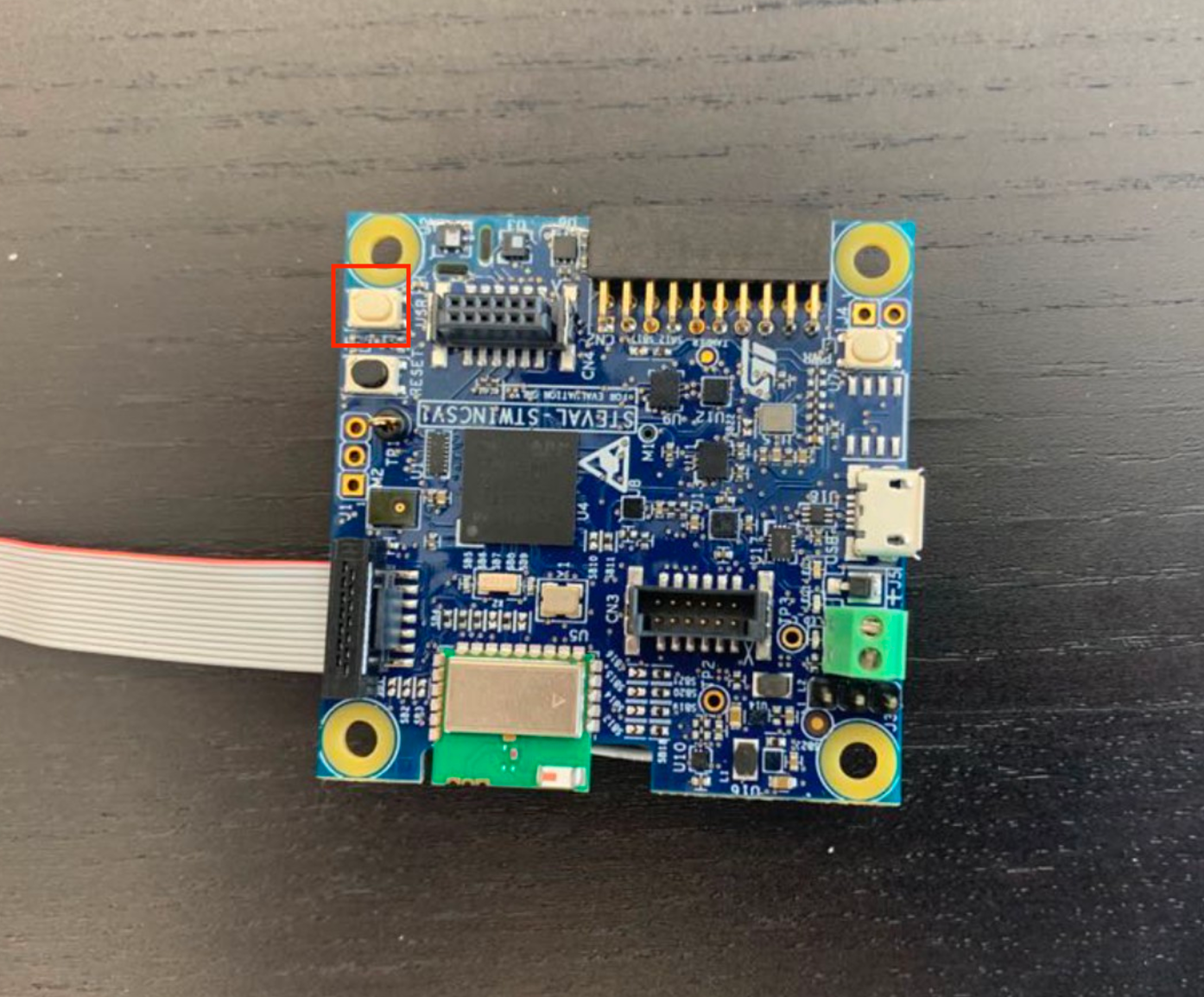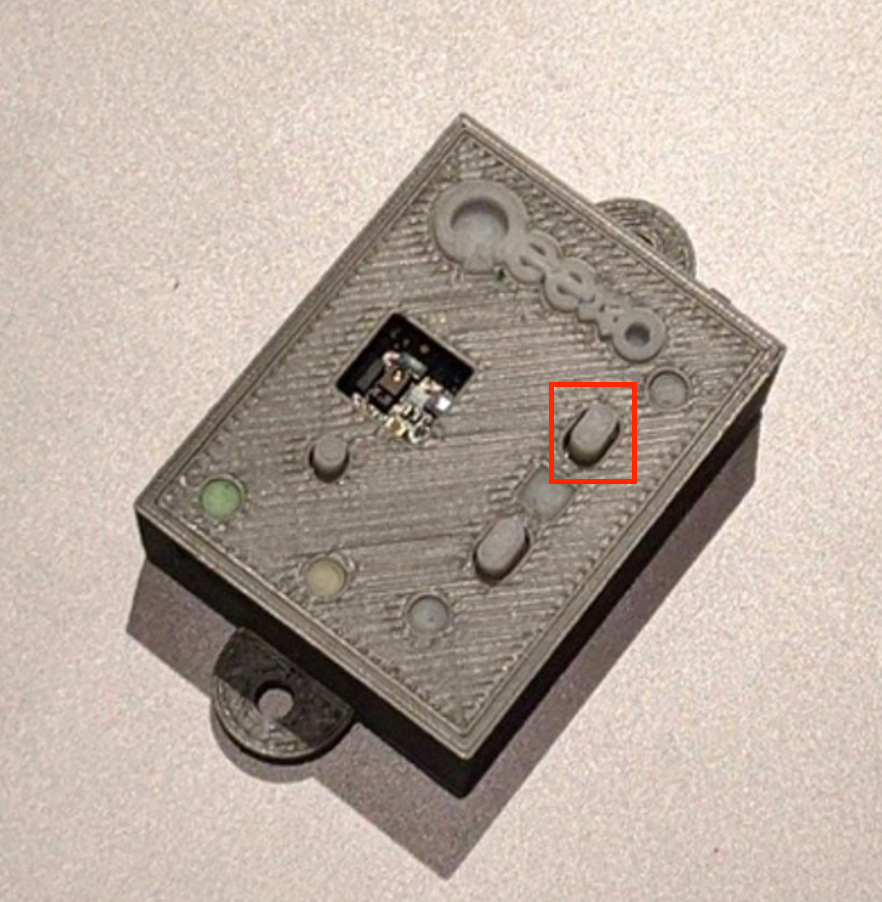Building Machine Learning Models
In this article:
Step 2a: Sensor Selection (applicable to non-MLC projects)
Option 1 - Automatic Sensor and Feature Group Selection
Option 2 - Manual Sensor Selection
Step 2b: Filter Configuration (applicable to MLC projects)
Option 1 - Automatic Filter and Feature Group Selection
Option 2 - Manual Filter and Feature Selection
Step 3a: Feature Selection (applicable to non-MLC projects)
Option 1 - Automatic Feature Selection
Option 2 - Manual Feature Selection
Step 3b: Feature Selection (applicable to MLC projects)
Step 4a: Inference Settings (applicable to non-MLC projects)
Option 1 - Determine automatically
Step 4b: Inference Settings (applicable to MLC projects)
Step 5: Model Selection & Settings
Multi-class Anomaly classification
Advanced setting for ML Static Library Memory Constraint
Model Performance - ML Model / Cross Validation / Latency / Size / Performance Summary…
Testing Model Performance on Test Data
Event Classification (Start/Stop)
Reading Inference from Hardware
Multi-class Classification Project
Single-class Classification Project
Multi-Class Anomaly Classification
Prerequisites
Sensor is already connected with your laptop through USB or bluetooth
Getting Started
Navigate to the Data page to build machine learning models with collected and/or uploaded training data.
Select training datasets that you want to use for building machine learning models by clicking the checkbox at the left of each Datasets.
*Note that the selected Datasets should ideally be from the same Environment, but Qeexo AutoML will allow you to train Datasets from different Environments as long as the selected sensors and Sensor Configuration are identical.
IN DEMO CASE we select all three dataset that we collected (see Collecting data steps at Data Management ).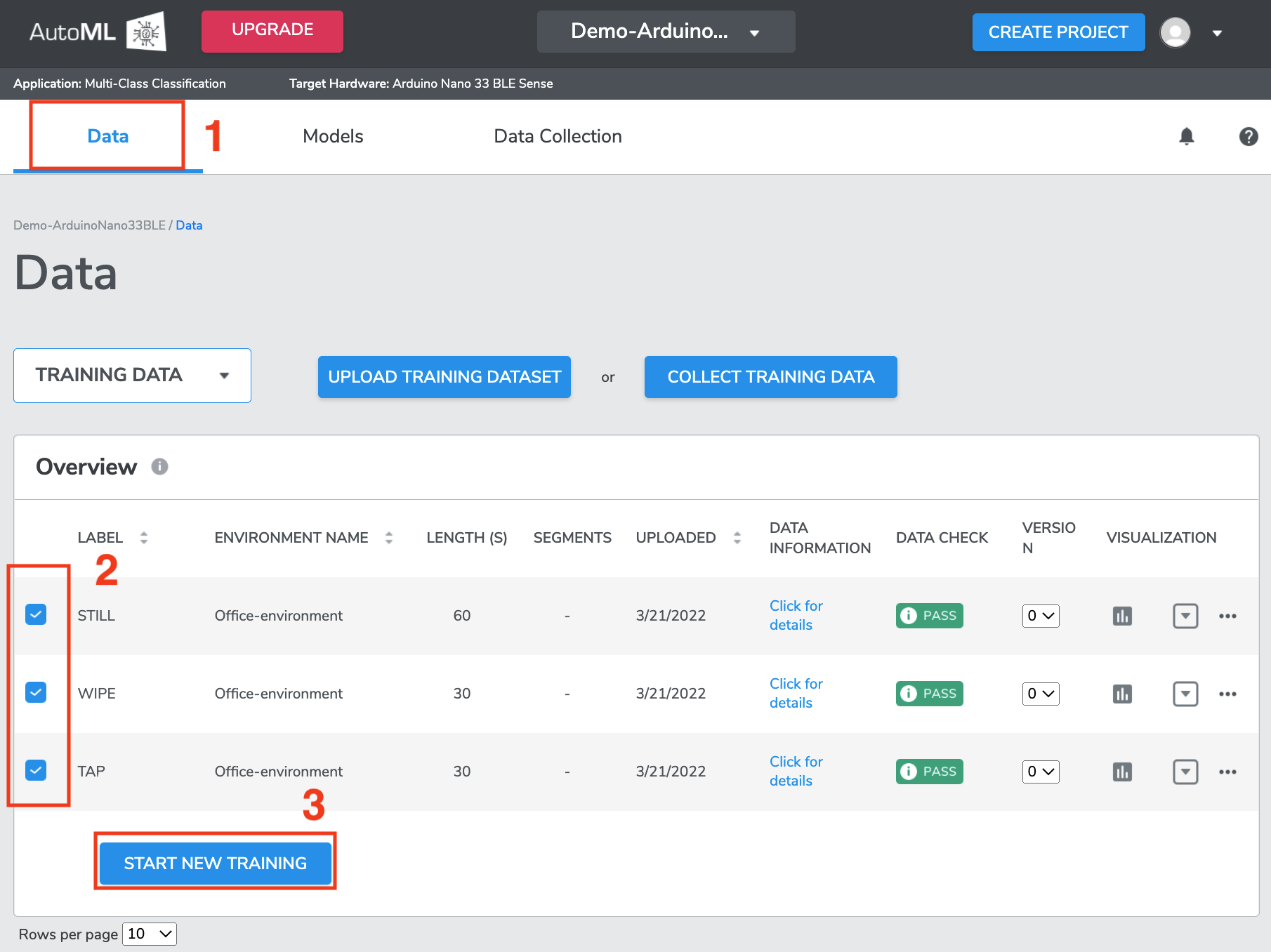
Once the desired Datasets are selected, click
START NEW TRAININGbutton to configure Training Settings.
*Note that theSTART NEW TRAININGbutton is only clickable when Datasets containing 2 or more Class Labels are selected in Multi-class classification project. However, for Single-class classification project, the button becomes clickable as soon as one Class Label has been selected.
*There is a minimum amount of data Qeexo AutoML needs for each Class Label in order to train machine learning models, this minimum is 640 samples from the highest ODR sensor. For example, if your sensor configuration is 104 Hz accelerometer & 25 Hz humidity, you need to collect data for at least 7 seconds (because 104 Hz * 6 seconds < 640 samples). Note that satisfying this minimum requirement does not guarantee performance/accuracy; it is just the minimum amount of data our platform will work with. For good performance, you should likely collect much more than this minimum amount of data.
Training Settings
Step 1: Group labels
This step is an optional step in case you want to group together multiple Class Labels into one Class Label before training the model.
This is an optional step that can be bypassed by pressing the SKIP button.
For example, for a single-class classification project applied to anomaly detection, you may have machinery data that is labelled based on two different types of motion: vertical rotation (UPDOWN) and horizontal rotation (LEFTRIGHT). Since both of these classes are expected behavior, it is convenient to group these labels as a "Normal" group to feed into single-class classification.
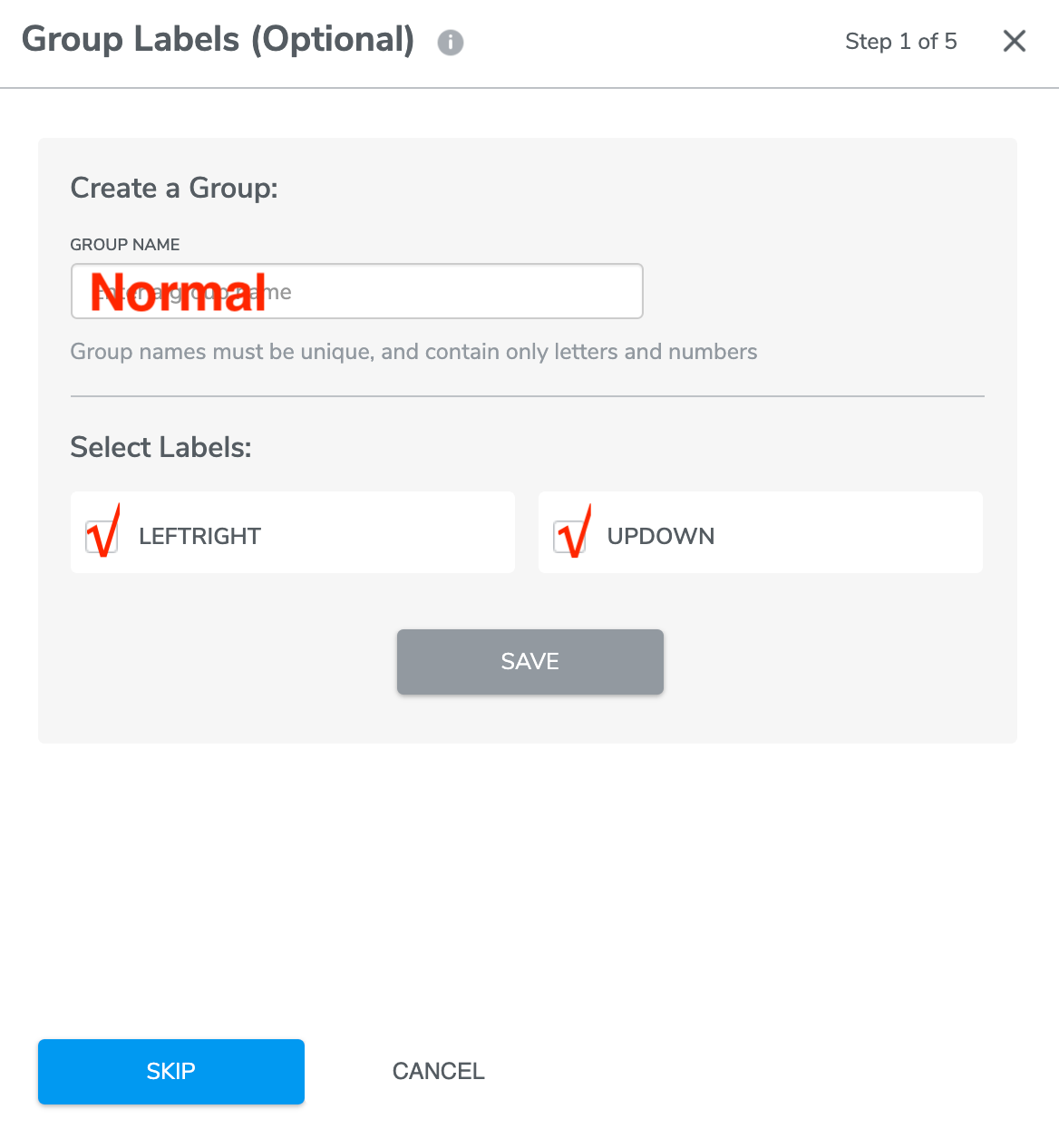
IN DEMO CASE we will skip Group Labels step as we don’t need to.
Step 2a: Sensor Selection (applicable to non-MLC projects)
Step 2a is for projects that is non-MLC project. If you have previously selected MLC for you project, follow Step 2b: Filter Configuration (applicable to MLC projects).
(click Working with Projects for more info regarding creating MLC projects)
There are two options for sensor selection - ‘Automatic Sensor and Feature Group Selection’ and ‘Manual Sensor Selection’.
Option 1 - Automatic Sensor and Feature Group Selection
This is an option to have Qeexo AutoML automatically select sensors and feature groups for optimal model performance. If you have collected data from multiple sensors, but you are not sure which may be helpful for the given problem, it is recommended to enable this feature.
*Note that this automatic selection applies to both sensor and feature groups. If you know what sensors should be used for the problem, but you still want to enable feature selection, that is possible on Step 3a: Feature Selection (applicable to non-MLC projects).
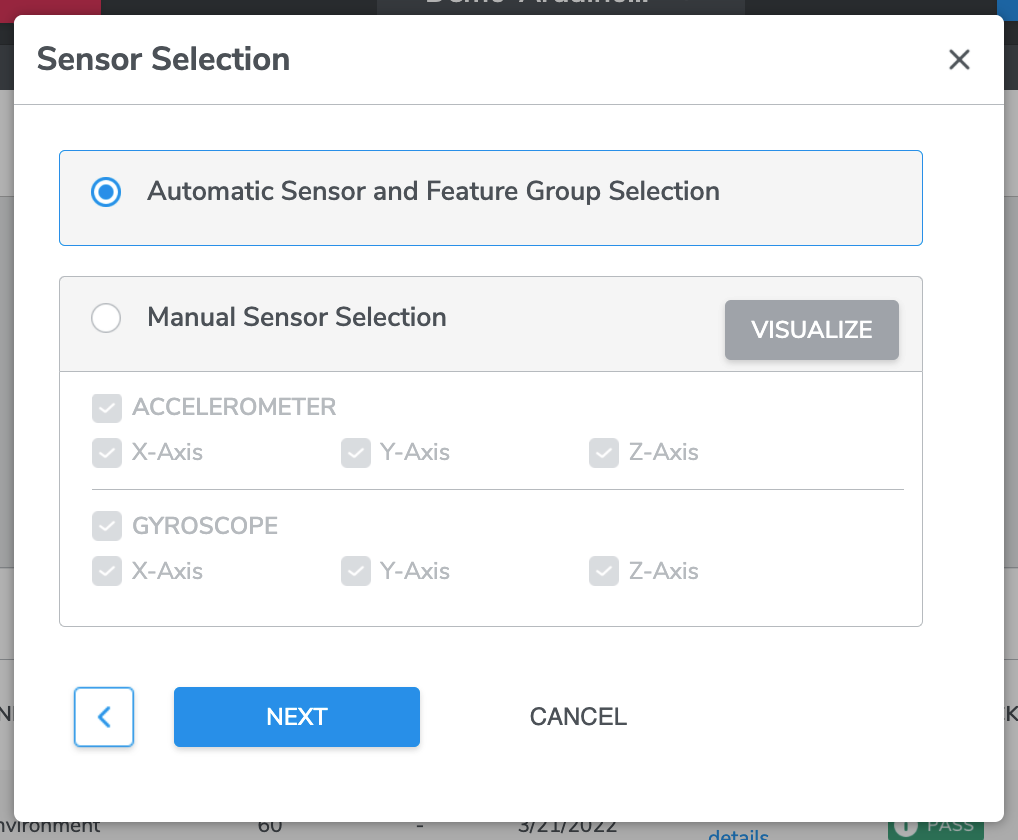
IN DEMO CASE we are going to select “Automatic Sensor and Feature Group Selection”.
Press NEXT when you are ready to proceed to the next step (Please advance to Step 4a: Inference setting (applicable to non-MLC projects)).
Option 2 - Manual Sensor Selection
With manual sensor selection option, you will be able to select a subset of sensor to feed into the Machine Learning pipeline.
*Note that:
All sensors included in Project Creation are available for selection in this stage
Individual axes from multi-channel sensors can be selected independently. These include:
X-, Y-, and Z-axis selection for Accelerometer, Gyroscope, and Magnetometer sensors
Red, Green, Blue and Clear Light channel selection for Ambient Light sensor
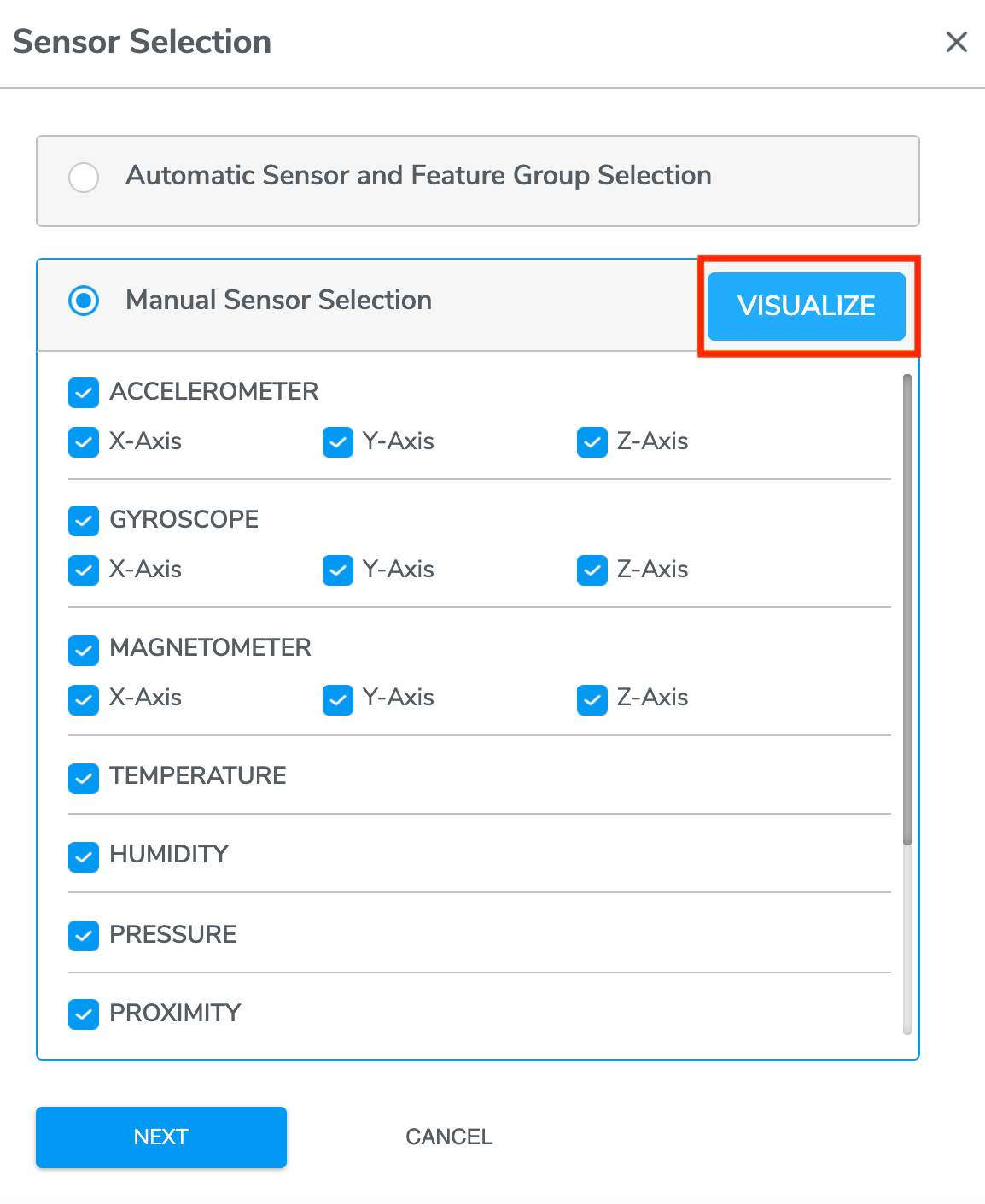
Under manual selection, you can VISUALIZE data collected from sensors using a general-purpose dimensionality reduction algorithms called UMAP (Uniform Manifold Approximation and Projection) and PCA (Principal Component Analysis).
- UMAP is a novel manifold learning technique for dimension reduction. For further details about UMAP algorithm, please refer to "UMAP: Uniform Manifold Approximation and Projection for Dimension Reduction" available at https://arxiv.org/abs/1802.03426 .
- PCA linearly transforms input features into a lower-dimensional space where the variance of the features is maximally preserved. PCA is very well established statistical technique for dimensionality reduction while preserving the variance. Similar to UMAP plot, we project features into two-dimensional space for the PCA visualization as well. These visualizations can often determine which sensors might be useful for classification.
Examining these UMAP and PCA plots before making a final manual sensor selection is encouraged.
Press NEXT when you are ready to proceed to the next step (Please advance to Step 3a: Feature Selection (applicable to non-MLC projects)).
Step 2b: Filter Configuration (applicable to MLC projects)
Step 2b is for projects that is MLC project. If you have previously selected non-MLC for you project, follow Step 2a: Sensor Selection (applicable to non-MLC projects).
(click Working with Projects for more info regarding creating non-MLC projects)
There are two options for Filter Configuration - ‘Automatic Filter and Feature Group Selection’ and ‘Manual Filter and Feature Selection’.
Option 1 - Automatic Filter and Feature Group Selection
If MLC users would like Qeexo AutoML to automatically choose filters and features for their models, select “Automatic Filter and Feature Group Selection” and click NEXT (please advance to Step 4b: Inference Settings (applicable to MLC projects)).
Option 2 - Manual Filter and Feature Selection
For the users who want to manually select filters, they can choose "Manual Filter and Feature Selection" and click NEXT.
Users will be able to configure up to 7 filters that are available in Machine Learning Core logic. Currently the following filters are available:
High-pass filter
Band-pass filter
IIR1 filter
IIR2 filter
Note that filter configuration is entirely optional.
Qeexo AutoML allows for filter to be added and removed:
*Note that V2-Axis means sum of squares of x, y, and z-axis (i.e. x^2+y^2+z^2) while V-Axis is the square root of V2-Axis (i.e. sqrt(x^2+y^2+z^2)).
Press NEXT when you are ready to proceed to the next step (Please advance to Step 3b: Feature Selection (applicable to MLC projects)).
Step 3a: Feature Selection (applicable to non-MLC projects)
Note that this step is automatically SKIPPED when "Automatic Sensor and Feature Group Selection" is chosen previously from Step 2a.
When you chose Manual Sensor Selection previously from step 2a, you will be presented options to select between ‘Automatic Feature Selection’ and ‘Manual Feature Selection’.

Option 1 - Automatic Feature Selection
If the “Automatic Feature Selection” option is chosen, Qeexo AutoML will select the optimal set of features based on final model accuracy as input into model training.
Press NEXT when you are ready to proceed to the next step (Please advance to Step 4a: Inference Settings (applicable to non-MLC projects)).
Option 2 - Manual Feature Selection
You may want to refer to the following description of features during Manual Feature Selection:
*Note that features are grouped under each sensor. For each of the selected sensors, at least one feature group is required under the manual mode.
Similar to sensor selection screen, users can visualize data collected from sensors as well as feature groups using the UMAP visualization tool described in the previous section.
Press NEXT when you are ready to proceed to the next step (Please advance to Step 4a: Inference Settings (applicable to non-MLC projects)).
Step 3b: Feature Selection (applicable to MLC projects)
Similar to Step 2b: Filter Configuration (applicable to MLC projects), users can add and remove feature manually.
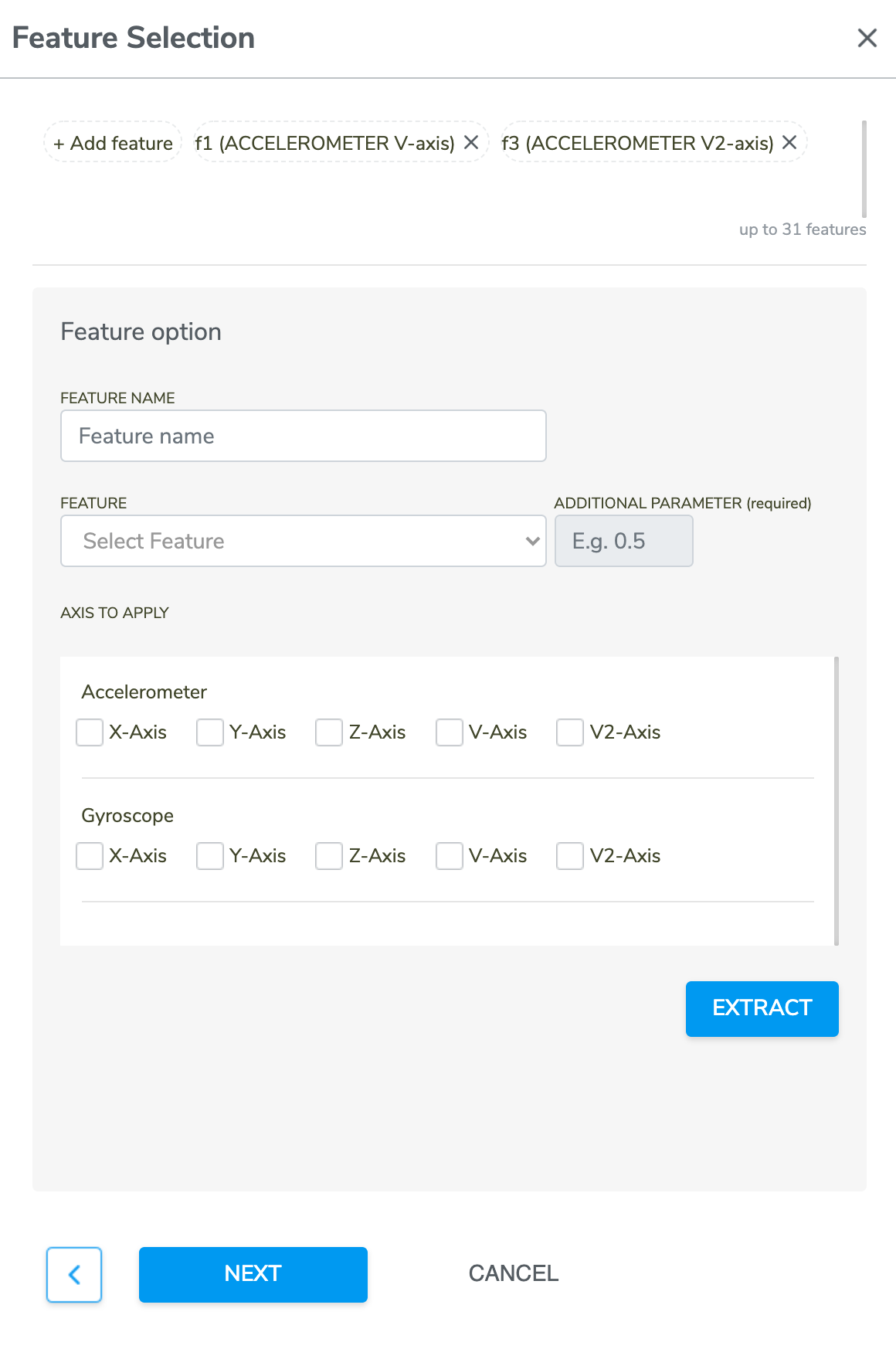
Refer to ST documentation for more details about the features available in MLC logic.
Press NEXT when you are ready to proceed to the next step (Please advance to Step 4b: Inference Settings (applicable to MLC projects)).
Step 4a: Inference Settings (applicable to non-MLC projects)
There are two options for Inference Settings which are ‘Determine automatically’ and ‘Enter manually’.
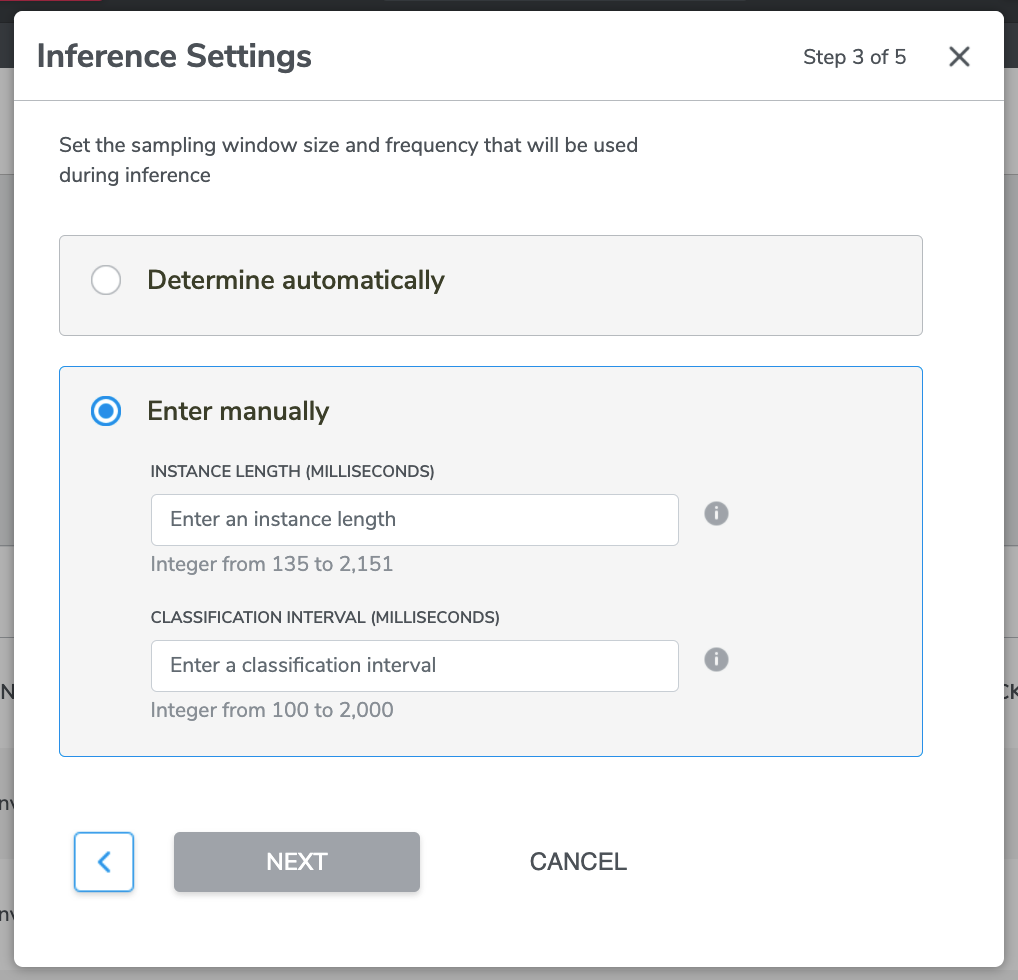
Option 1 - Determine automatically
If you select the Determine automatically option, press NEXT to proceed to Step 5: Model Selection & Settings.
IN DEMO CASE After we selected “Automatic Sensor and Feature Group Selection” in Step 2a, here we continue select “Determine automatically” option.
Option 2 - Enter manually
There are two information for you to insert which are “INSTANCE LENGTH (MILLISECONDS)” and “CLASSIFICATION INTERVAL (MILLISECONDS)”.
- INSTANCE LENGTH (MILLISECONDS)
This is sets the length of the sensor data which the model will use to make a prediction, aka what time length of data you would like the model to use to make a prediction. The maximum allowable value for this property is set based on the highest sensor ODR in the given sensor configuration.
The optimal value depends on the real-world time duration of the events corresponding to the Class Labels that you want to capture/detect with the sensors, as well as the selected ODRs used during data collection.
For example, in machine vibration problems, the most important requirement for the signal data is high ODR, because higher ODRs will increase the amount of high frequency information available to the model. For these type of problems, we should often use the highest available sampling rate, and then use the maximum allowable instance length for that ODR (~300 ms @ 6.6kHz).
However, in human activity detection and monitoring, 300 ms would likely not be a sufficient instance length for good performance. We need to make sure the window is long enough to capture some human motion and interaction with the environment, which may require several seconds of data in total. For this case, we should pick an instance length which we want to achieve (e.g. 5000 ms), and then we should use the highest possible ODR which still allows us to achieve this instance length.
- CLASSIFICATION INTERVAL (MILLISECONDS)
This sets the number of milliseconds between requests for classification, aka how often the model makes a prediction once.
For example, if Classification Interval is set to 200 ms, Qeexo AutoML will produce a classifier that classifies incoming data at a rate of 5 Hz.
This value should be set relative to the average time between class changes in the real world -- if the classes may change quickly or last for a very short period of time, Classification Interval needs to be set low so that classifications are run near-constantly in order to capture the events of interest.
For problems like human presence detection, where based on the nature of the problem the classes cannot change often, we may select a higher value (e.g. 2000 ms) in order to save on power consumption and network bandwidth.
Once you are ready, press NEXT to proceed to Step 5: Model Selection & Settings.
Step 4b: Inference Settings (applicable to MLC projects)
MLC has two attributes affecting model inference: ‘Window length’ and ‘MLC output data rate’.
(1) Window Length
All the features are computed within a defined time window, which is called Window length. It represents number of samples, ranging from 1 to 255. Depending on the pipeline configuration, the allowed range for the Window Length may be subject to further restrictions to ensure a minimum number of training instances are created per class label.
(2) MLC Output Data Rate
This parameter governs how fast MLC outputs classification result. Four rates are available: 12.5 Hz, 26 Hz, 52 Hz, and 104 Hz. This parameter must be less than or equal to the Inertial Measurement Unit (IMU) output data rate (ODR). When the MLC ODR is less than the IMU ODR, the sensor data will be downsampled inside the MLC to the MLC ODR before being used in the machine learning model.
Once you are ready, press NEXT to proceed to Step 5: Model Selection & Settings.
Step 5: Model Selection & Settings
This page is for you to select which model type(s) are trained. We are going to discuss steps with respect of different Classification Type - including ‘Single-Class Classification’, ‘Multi-Class Classification’ and ‘Multi-Class Anomaly Classification’. Please refer to your previous selected “Classification Type” for your project.
For multi-class classification, it also contains switches for enabling a few different features related to model building.
Note that only one model (Decision Tree) is available for MLC projects.
A. Single-Class Classification
1. Algorithm Selection
For Single-Class Classification, Qeexo AutoML supports the following machine learning algorithms
*Selecting more than one type of algorithm is recommended, so that results could be compared.
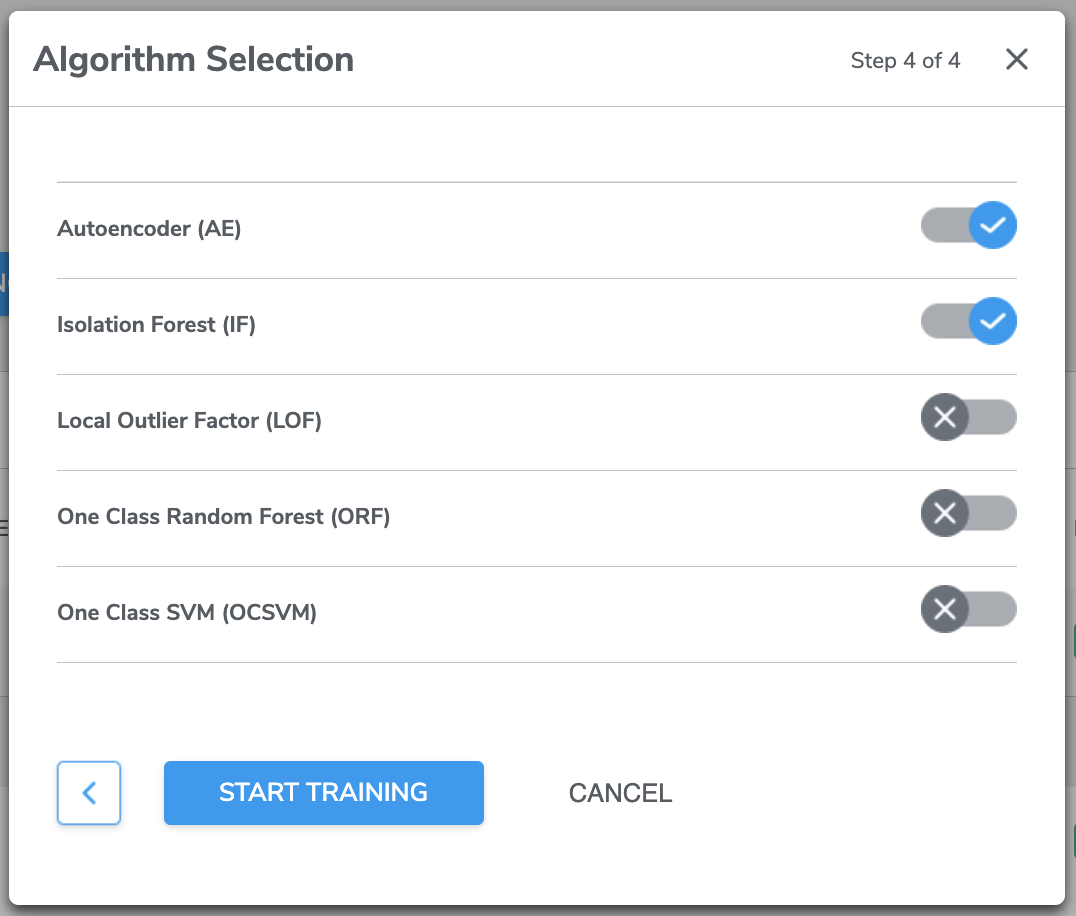
Select the algorithm(s) you want to train the model by clicking the Switch button. You can chose one or more algorithms.
Then click START TRAINING to proceed to Training Process.
B. Multi-Class Anomaly Classification
1. Algorithm Selection
For Multi-Class Anomaly Classification, Qeexo AutoML supports the following machine learning algorithms
*Selecting more than one type of algorithm is recommended, so that results could be compared.
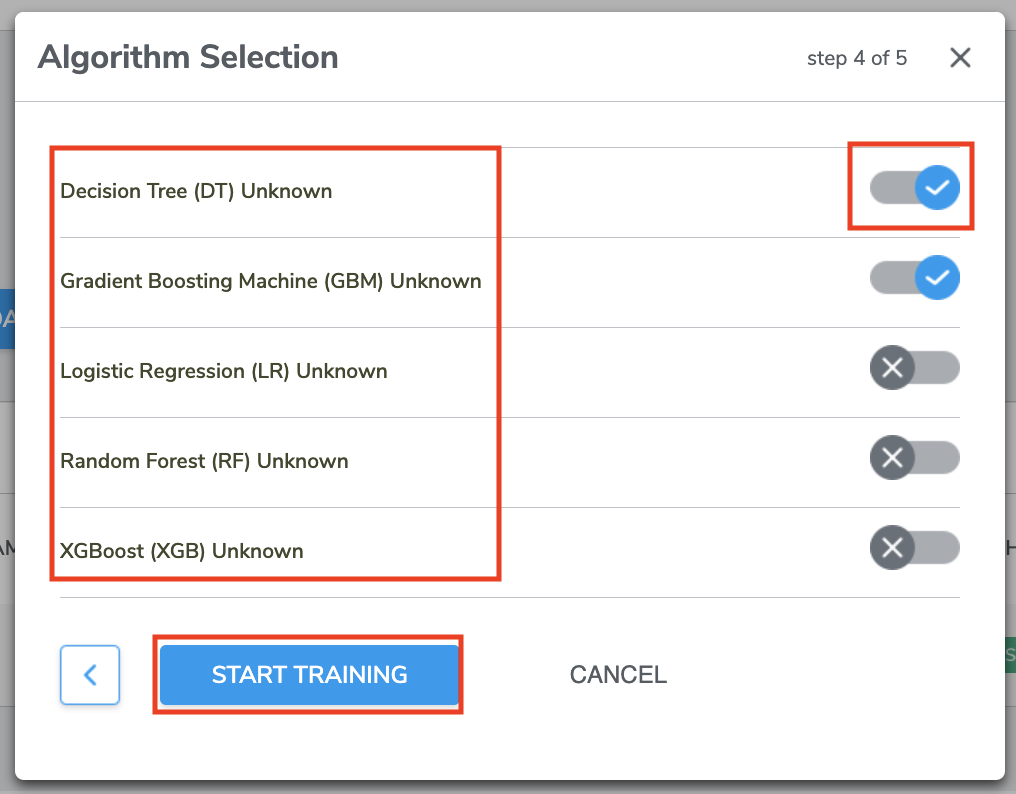
Select the algorithm(s) you want to train the model by clicking the Switch button. You can chose one or more algorithms.
Then click START TRAINING to proceed to Training Process.
C. Multi-Class Classification
1. Algorithm Selection
For Multi-Class Classification, Qeexo AutoML supports the following machine learning algorithms
*Selecting more than one type of algorithm is recommended, so that results could be compared.
Support for additional algorithms will be added in the future
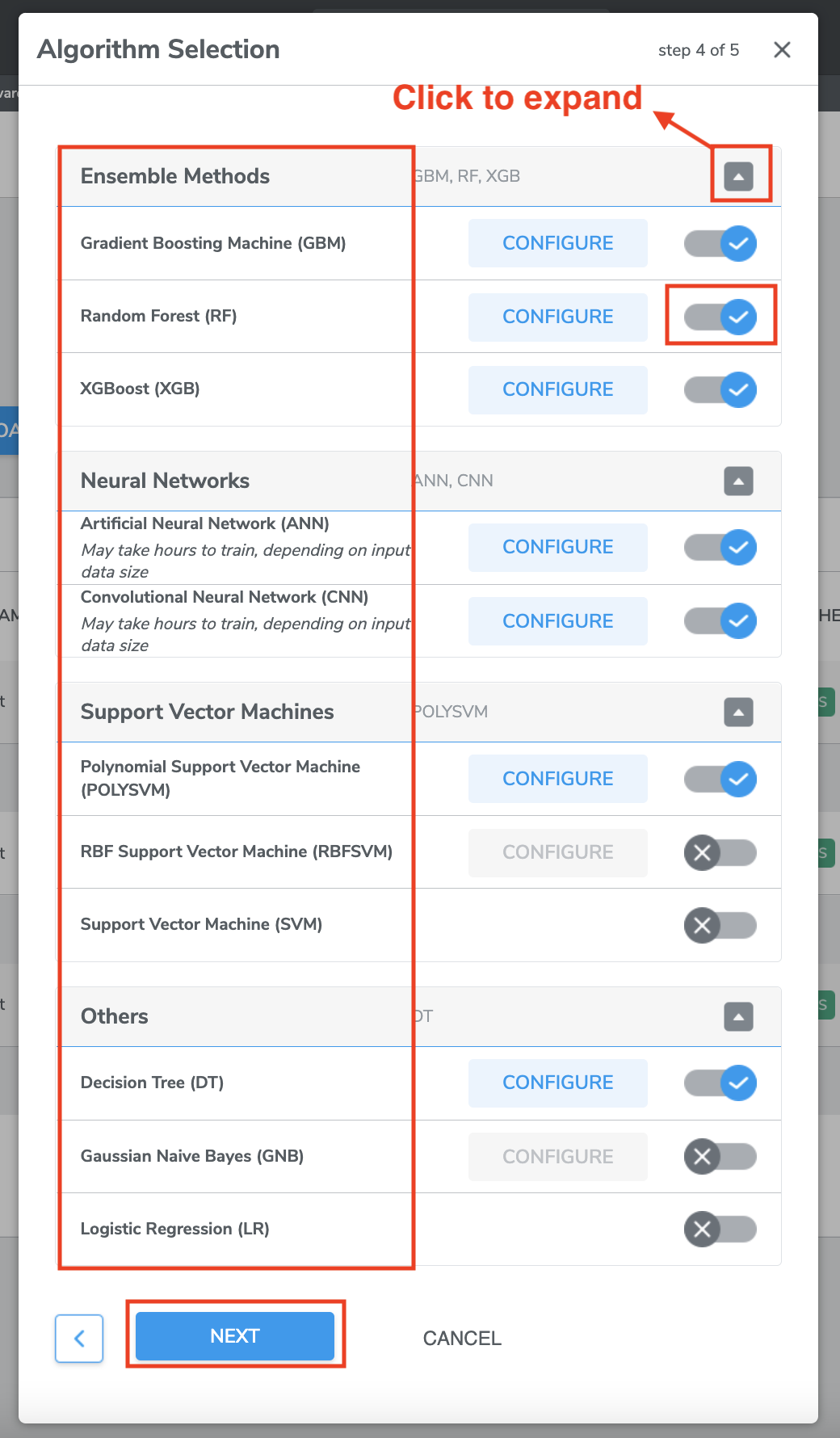
*Note that Neural Networks models may take longer to train, due to the significant computation required for the training process.
*Additional - the CONFIGURE button
Note: many of these parameters interact with each other in unique and non-intuitive ways. Unless you have significant experience tuning deep learning models, you may want to consider using the automatic hyperparameter optimization tool.
Pressing CONFIGURE (available for some models) will yield the following configuration screen:

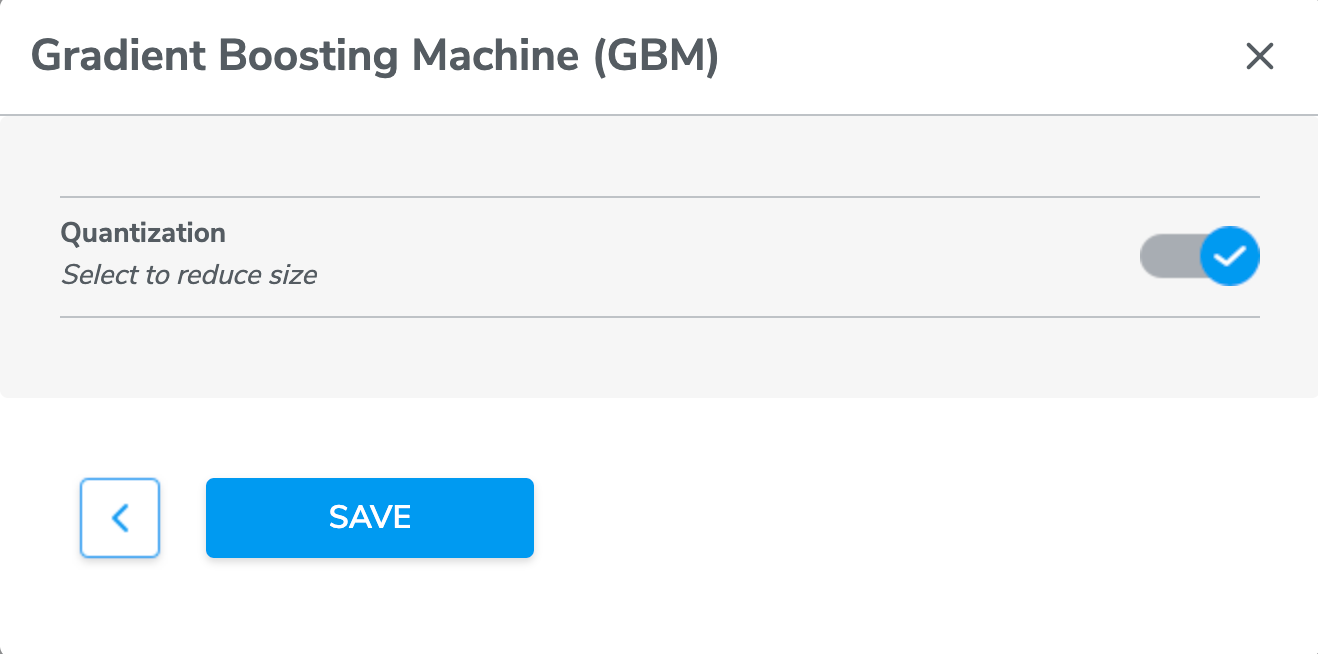
Quantization denotes an option to conduct quantization - aware training so as to achieve model size reduction.
There are additional configurable options to fine tune the ANN model
Similarly there are configurable options to fine tune the CNN and RNN model
Configuration sub-menu for other algorithms will be added in the future
Select the algorithm(s) you want to train the model by clicking the Switch button. You can chose one or more algorithms.
Then click NEXT to proceed to Model Settings.
IN DEMO CASE We are going to select all available algorithms, then click NEXT to proceed to Model Settings page.
2. Model Settings
There are two parts in Model Settings page for you to select and input information which are ‘Generate Learning Curve(s)’ and ‘Hyperparameter Tuning’.

(1) Generate Learning Curve(s)
If enabled, this option will produce learning curves for the given data set. Learning curves visualize how your model is improving as more data is added. These curves can be extrapolated, which can be useful for determining if the model may benefit from additional data collection.
As shown in the example below, the "Circle" and "Punch" gestures are still improving with additional data. It is likely that they would continue to improve if more data is collected.
*Note: If the dataset that is used for training is very small, the learning curves may not be accurate. The model may be very good at classifying the limited data it's seen, but might not generalize to new cases. In that case, even if the learning curve does not show it, it is safe to assume that final model performance will improve with additional data collection.
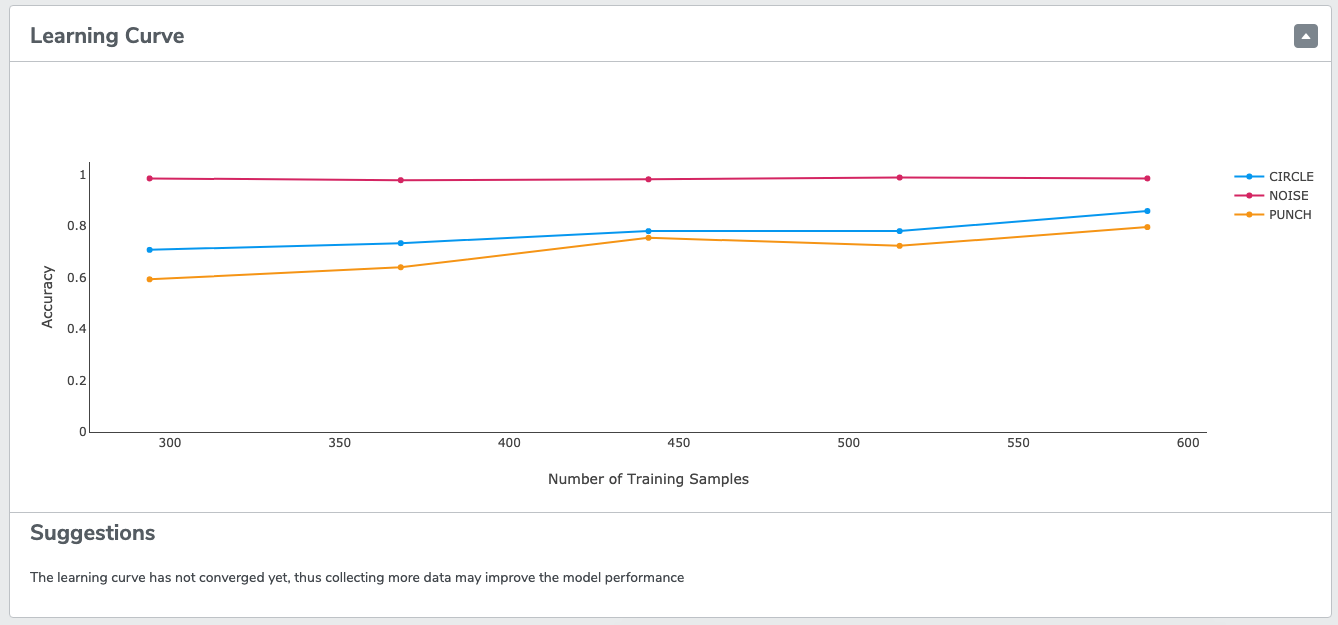
(2) Hyperparameter Tuning
Hyperparameters are a set of adjustable parameters of machine learning models. These parameters affect the accuracy, runtime, and size of machine learning models. Different models have different parameters depending on the model architecture. AutoML provides built-in option for tuning these hyperparameters. There is a simply switch users need to flip if hyperparameter optimization is desired. If this option is enabled, AutoML tunes hyperparameter using a collection of optimization techniques tailored to TinyML applications. It maximizes accuracy while it ensures that all resource usages are under constraints (e.g., firmware binary size and memory usage). This option will often improve final model accuracy at the expense of additional runtime for model-building.
There are three settings that affect the duration of the hyperparameter tuning stage:
- Optimizer Time Limit:
- Optimizer Number of Trials:
- Optimizer Error Threshold:
Once you are ready, click START TRAINING to proceed to Training Process.
IN DEMO CASE For Model Settings, we will leave everything as default, simply click START TRAINING to proceed.
D. Advanced setting for ML Static Library Memory Constraint
When Pro Tier users select data collections and continue to click START NEW TRAINING button to start the model training, we added a new advanced option to allow users to configure ML Static Library Memory Constraint, more specifically, users could set the target ML Static Library maximum flash and RAM memory size usage as desired.

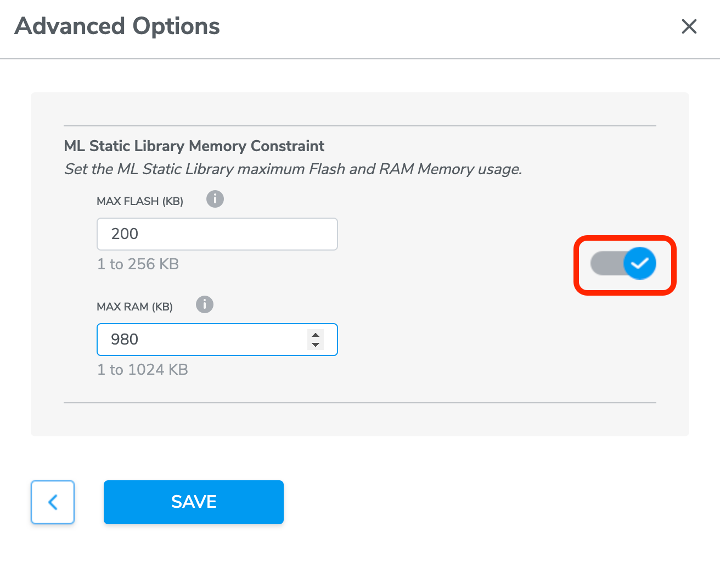
In the Algorithm Selection window, user could click CONFIGURE button to access to the Memory Constraint feature. The toggle on the right side should be enabled before users type in any values in the field on the left side.
Training Process
Once you clicked "START TRAINING" with one or more selected machine learning algorithms, the training process will begin.
Real-Time Training Progress pops up after training begins. The top row shows the progress of common tasks (e.g. featurization, data cropping, etc.) shared between different algorithms, followed by the build progress of each of the selected models.
At the end of the training process, Qeexo AutoML will flash, in sequence, each of the built models to the hardware device to test and measure the average latency for performing classifications.
Training Result
Click "TRAINING RESULT" to navigate to the Models page (also reachable from the top navigation bar), where all of the previous trainings will be listed, with the most recent one on top.
The current training will be expanded to show relevant information about model performance, including ML MODEL (the type of machine learning model), CROSS VALIDATION accuracy, LATENCY, SIZE, and additional PERFORMANCE SUMMARY. It also allows you to SAVE each model to your computer, PUSH TO HARDWARE (push a selected model to Target Hardware for LIVE TEST), LIVE CLASSIFICATION ANALYSIS and DELETE the model.
Testing Model Performance on Test Data
You can test all your ML models' performance by using the uploaded test data (if you have previously uploaded test data).
Click the button under EDIT TEST DATA.
A window will pop out. Here Test Data collections on the left may be linked to Training Data collections on the right by clicking the checkbox for the row and selecting the desired training collection form the drop-down.

Select at least one data by clicking the check button on the left. Clicking SAVE will dispatch the test run and evaluate the model's performance using the linked test data.
Once the evaluation is completed, you can find the result of Model performance on Test Data by clicking the buttons under “PERFORMANCE SUMMARY” of each model.
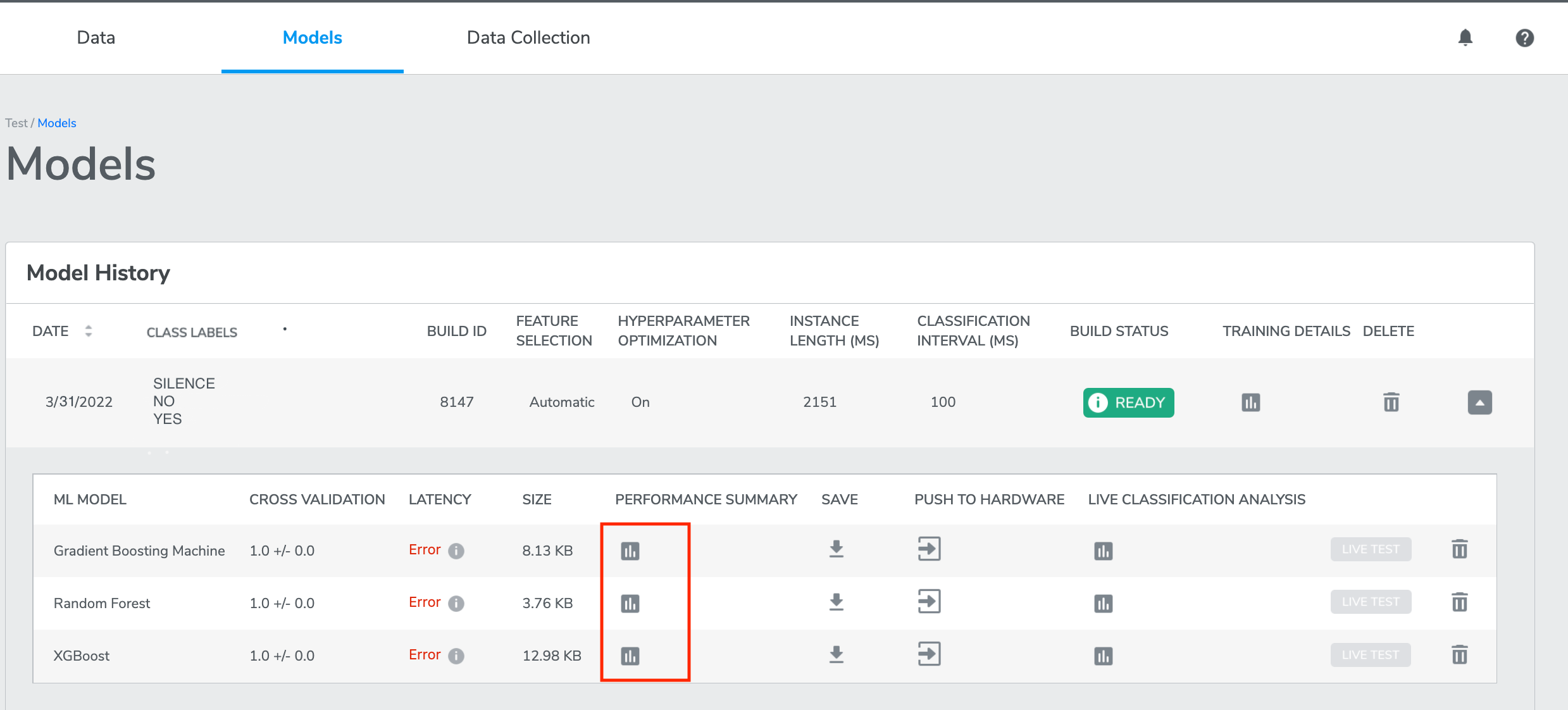
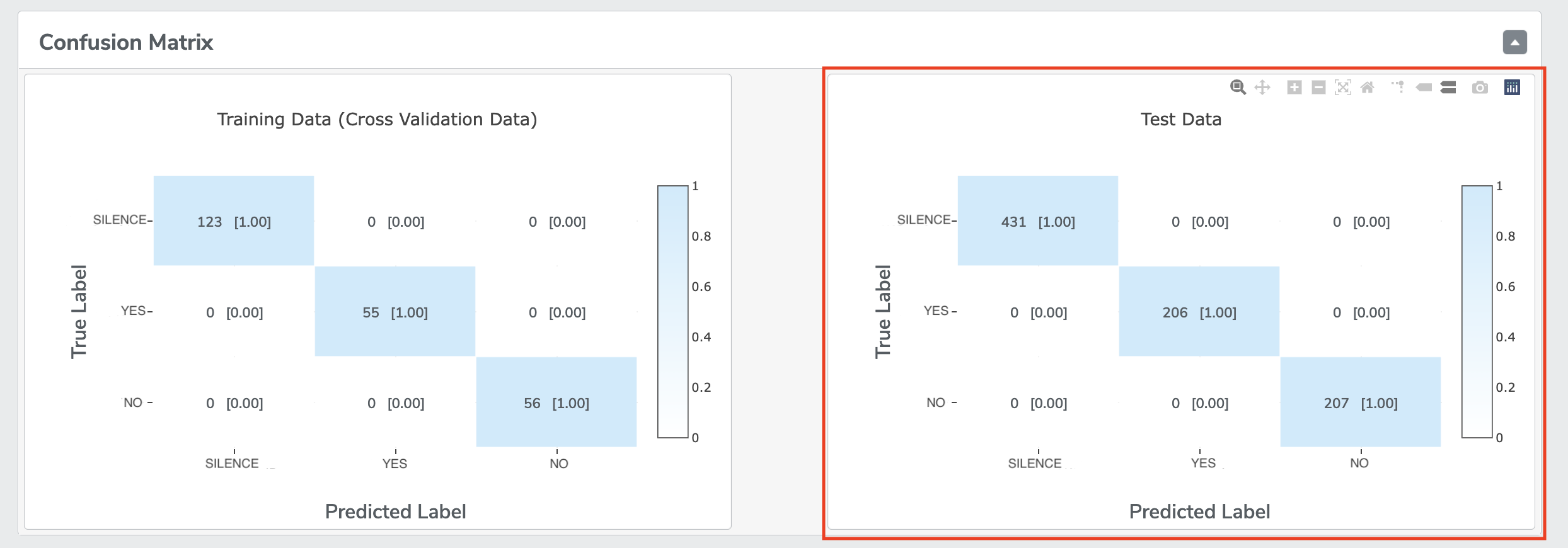
Live Testing
From the Test Result Page, you can select a model out of your interest, click the Arrow button under PUSH TO HARDWARE to flash the model to the Target Hardware. Note that the Target Hardware MUST BE connected to your laptop.
Once the model has been PUSH TO HARDWARE, LIVE TEST becomes clickable, and will take you to Live Testing Page.
Here in the Live Testing page, you can perform live-testing. The screen will display the current class that is predicted by the model that was flashed to the Target Hardware, based on the signals from the enabled sensors for this Project.
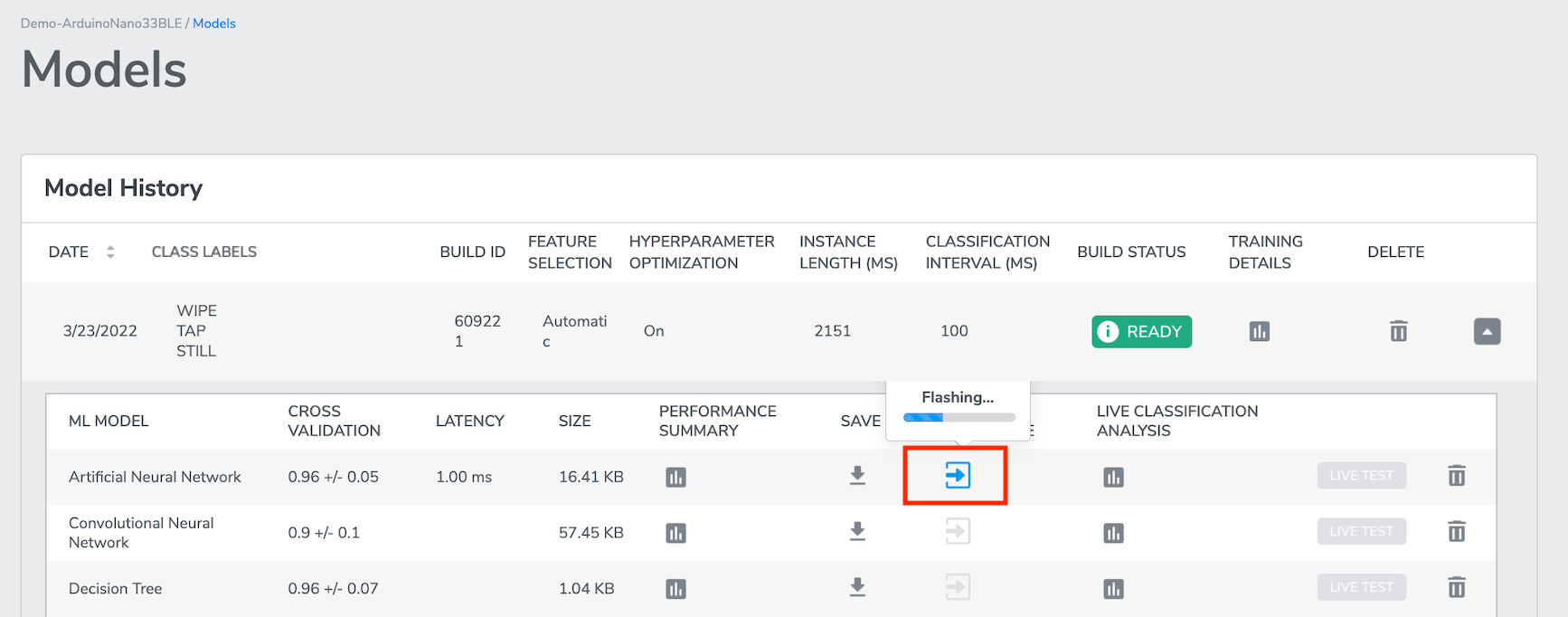


Classification Methods
There are two classification methods which are Continuous Classification and Event Classification (Start/Stop).
1. Continuous Classification
Continuous classification is selected on the live test page as default. In continuous classification, the live test screen will display the classification result one after another in a rate you set previously in classification interval. Continuous classification is recommended when the training sets are all continuous data.
2. Event Classification (Start/Stop)
In event classification, the model will only read the sensor input within the event window, and give one prediction after each event.
Event classification is recommended when the training set contains segments.
Using GUI button: Press START and begin performa the event. The prediction result will display on the screen after the event ends by either pressing STOP or the n second of event length is up.
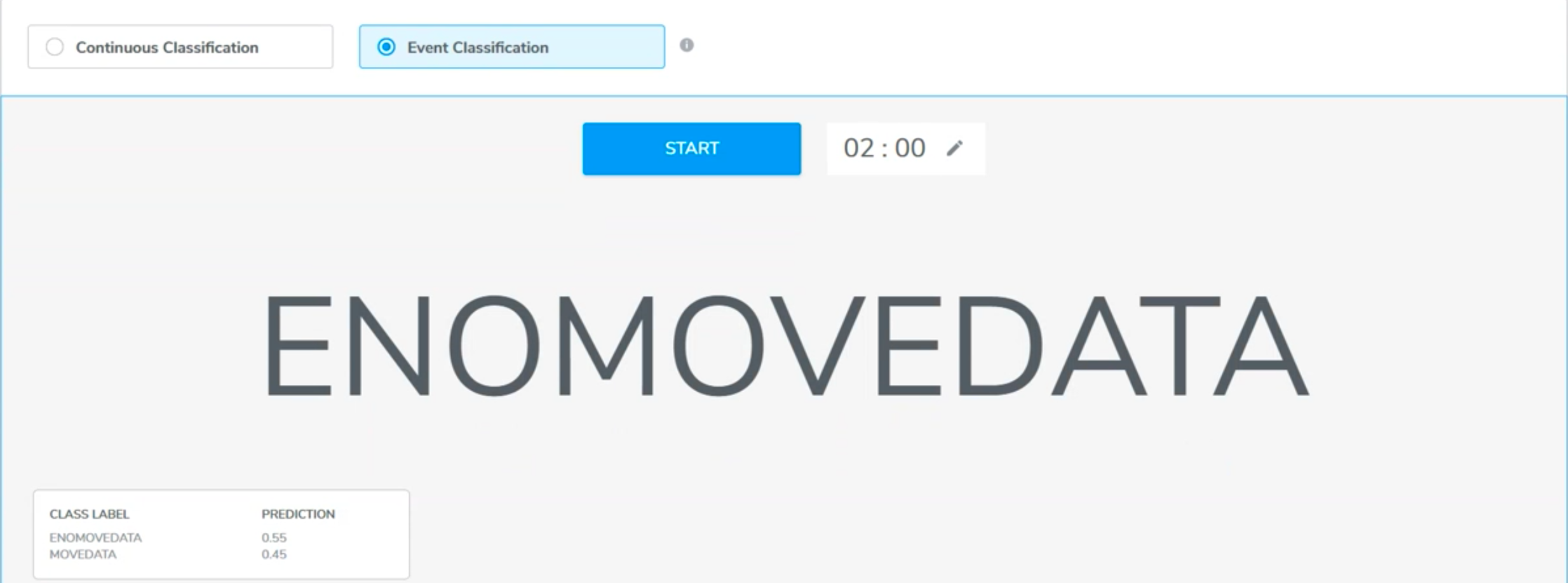

AutoML also supports event classification using hardware button for some target hardware. Press the button on the device to begin the event. The prediction result will display on the screen after the event ends either by releasing the button or the n second of event length is up.
Connection Methods
Click the SELECT CONNECTION METHOD, You can choose between USB and Bluetooth for your device connection.
(1) When you press CONNECT for Bluetooth, a screen similar to the following will be presented:
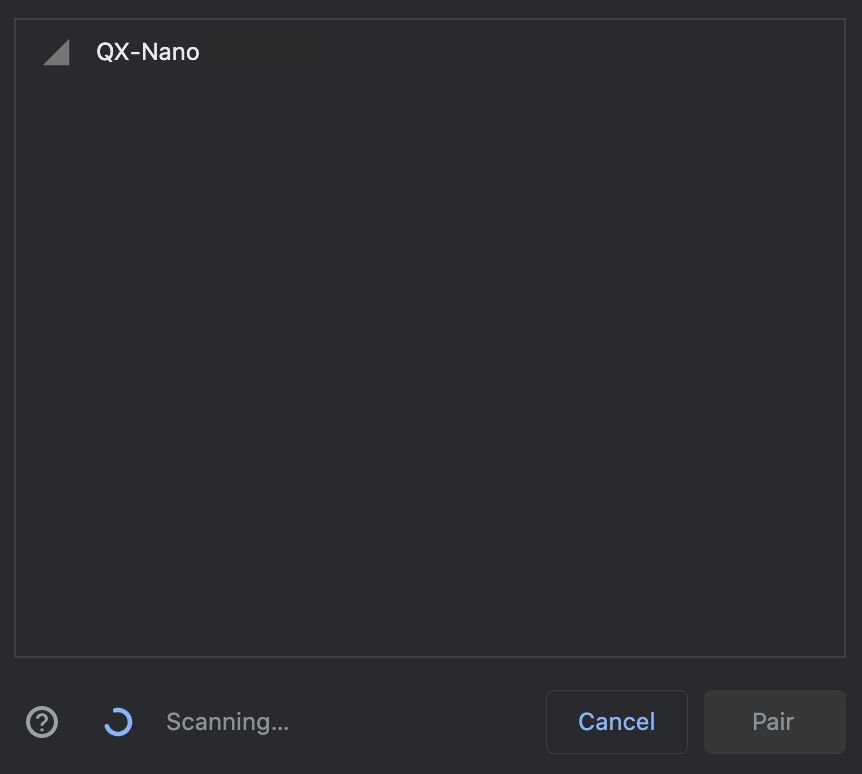
There may be more than one device ready to connect. If so, please choose the one starting with "QX - Nano" to pair with your device.
(2) When you press CONNECT for USB, Live Testing will be conducted via the connected USB cable and no further connection action is required.
For Single-class classification, USB is the only connection method. This is due to limitations for the Manual Calibration option (described below).
Reading Inference from Hardware
We are going to discuss this section with respect to different type of classification type - Multi-class Classification Project, Single-class Classification Project and Multi-Class Anomaly Classification.
(1) Multi-class Classification Project
The machine learning model during live classification outputs two pieces of information: the current predicted class label and the current model output values (called "Probability" in the web app) for each class.
The current predicted class label is based on the class with the highest model output value. Some weighting may also be applied for certain problems, so there may appear to be a minor delay between the maximum class "Probability" and the predicted class label.
The probability table of all class labels are presented as reference.
(2) Single-class Classification Project
For single-class classification, the machine learning model outputs the same two pieces of information. In this case, there will always only be two classes displayed: the given class and the anomaly (i.e. "NON_*") class.
After your single-class model is trained, it may be beneficial to calibrate the threshold of your model to tailor-fit your use case and application scenario. Begin the calibration process by clicking "MANUAL CALIBRATION".
Scores for single-class classifiers are in the range (0, 1], i.e., 0 < Score <= 1. Whether the given instance belongs to the given class or the anomaly class is determined by thresholding the Score, as shown below:
if Score < threshold:
Signal is Normal
else:
Signal is Abnormal (i.e. Anomaly)In the Manual Calibration menu, you can see scores (the blue line) generated by the single-class model plotted over time. Qeexo AutoML recommends an initial threshold based on an analysis of the training data, which is shown by the dotted red line. Users can change the threshold and flash the new, manually-selected threshold to the embedded target. The most recent user-selected threshold is shown in the plot by the dotted green line.
General rules of thumb for threshold tuning is the following:
If you want to be very sensitive to potential anomalies, you should set the threshold to be lower. That means that even small variations in the sensor data away from the collected operating condition would trigger an anomaly. However, please beware that setting the threshold too close to zero may result in too many false positives.
Likewise, if you only want to detect obviously anomalous data, you should keep the threshold to be higher. That means that minor variations in the sensor data away from the collected operating condition may not trigger anomalies.
Please find right balance by doing live classification experiments through live classification after flashing a range of thresholds to the embedded device.
(3) Multi-Class Anomaly Classification
The machine learning model during live classification outputs two pieces of information: the current predicted class label and the current model output values (called "Prediction" in the web app) for each class or the unknown class (If the new datapoint is sufficiently different from any of the training classes). The current predicted class label is based on the class with the highest model output value. In other word, the output can be any of the classes you previously collected just like the Multi-Class classification AND the anomaly (Unknown) class.
The probability table of all class labels are presented as reference
Test Replay (Asynchronous Live Testing)
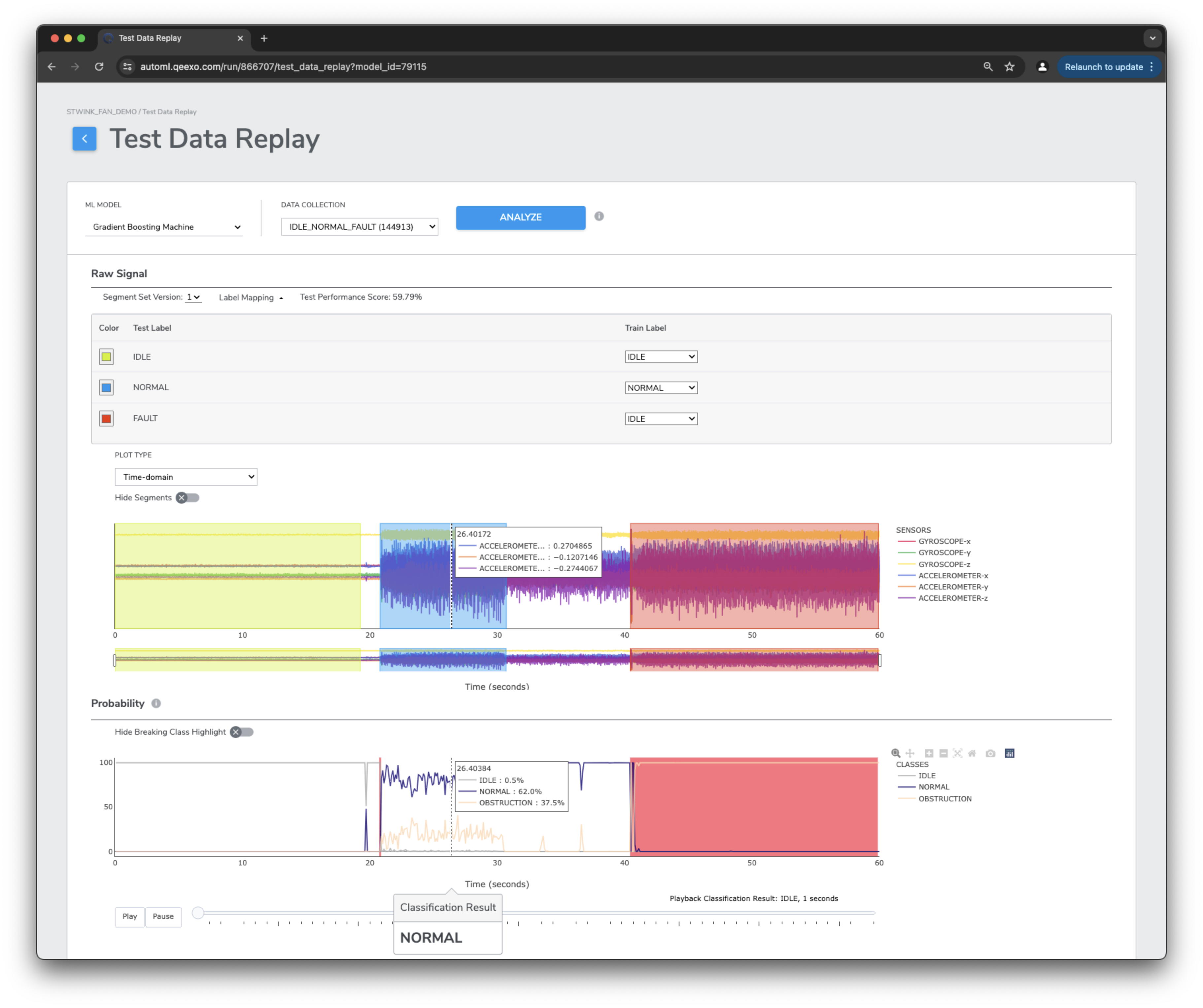
Live Replay provides users with accurate asynchronous live testing capabilities, even without hardware. From the models grid select Live Replay, then choose your test data from the drop dop-down and click Analyze. Behind the scenes Qeexo AutoML will feed your data bit-by-bit into your model and produce inference results that can be replayed at any time. Test replay will also provide you with insights into breaking classes when labeled data doesn’t perform as expected.

